Organization and Leadership Report 2022
VerifiedAdded on 2022/09/12
|23
|4910
|17
AI Summary
Contribute Materials
Your contribution can guide someone’s learning journey. Share your
documents today.
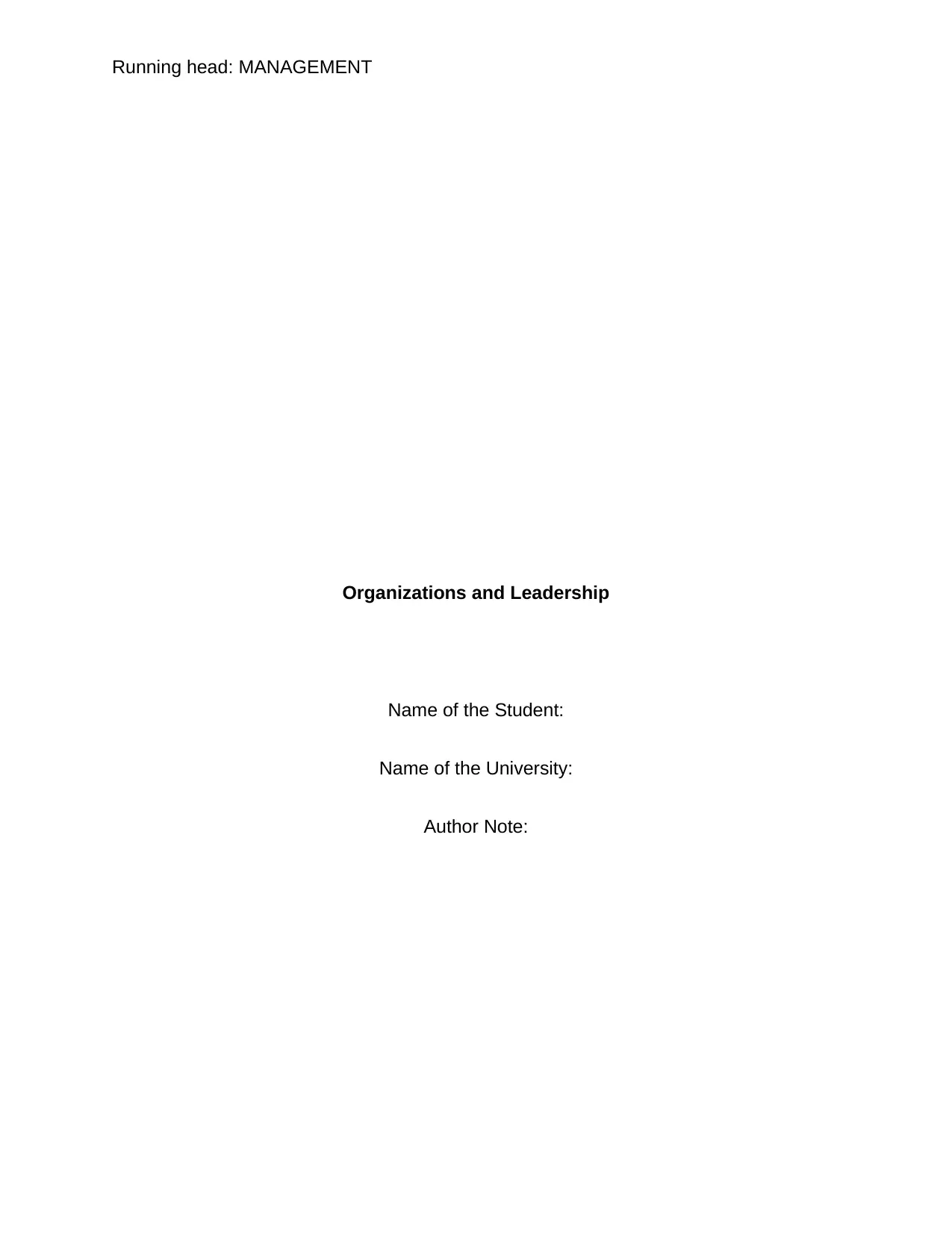
Running head: MANAGEMENT
Organizations and Leadership
Name of the Student:
Name of the University:
Author Note:
Organizations and Leadership
Name of the Student:
Name of the University:
Author Note:
Secure Best Marks with AI Grader
Need help grading? Try our AI Grader for instant feedback on your assignments.
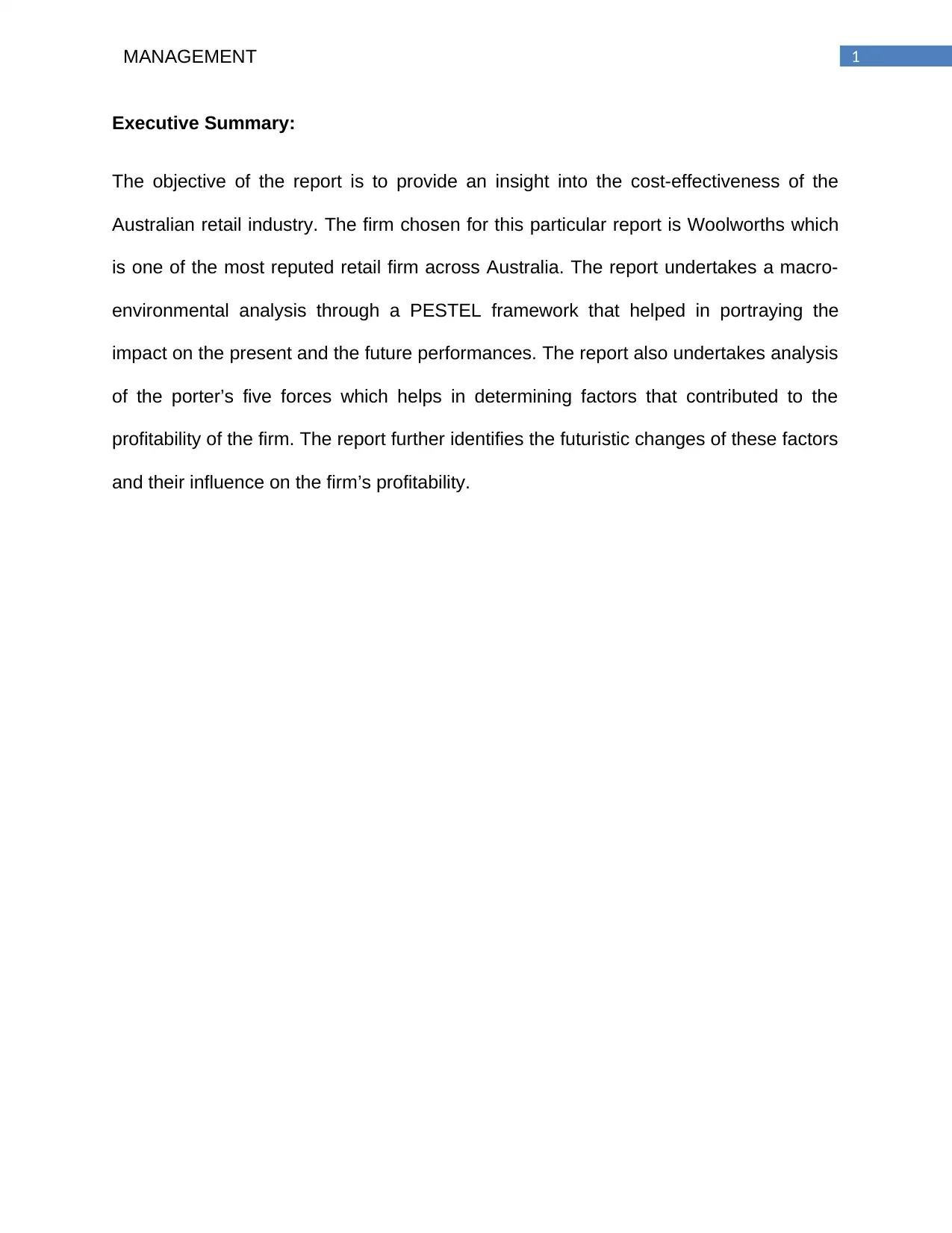
MANAGEMENT 1
Executive Summary:
The objective of the report is to provide an insight into the cost-effectiveness of the
Australian retail industry. The firm chosen for this particular report is Woolworths which
is one of the most reputed retail firm across Australia. The report undertakes a macro-
environmental analysis through a PESTEL framework that helped in portraying the
impact on the present and the future performances. The report also undertakes analysis
of the porter’s five forces which helps in determining factors that contributed to the
profitability of the firm. The report further identifies the futuristic changes of these factors
and their influence on the firm’s profitability.
Executive Summary:
The objective of the report is to provide an insight into the cost-effectiveness of the
Australian retail industry. The firm chosen for this particular report is Woolworths which
is one of the most reputed retail firm across Australia. The report undertakes a macro-
environmental analysis through a PESTEL framework that helped in portraying the
impact on the present and the future performances. The report also undertakes analysis
of the porter’s five forces which helps in determining factors that contributed to the
profitability of the firm. The report further identifies the futuristic changes of these factors
and their influence on the firm’s profitability.
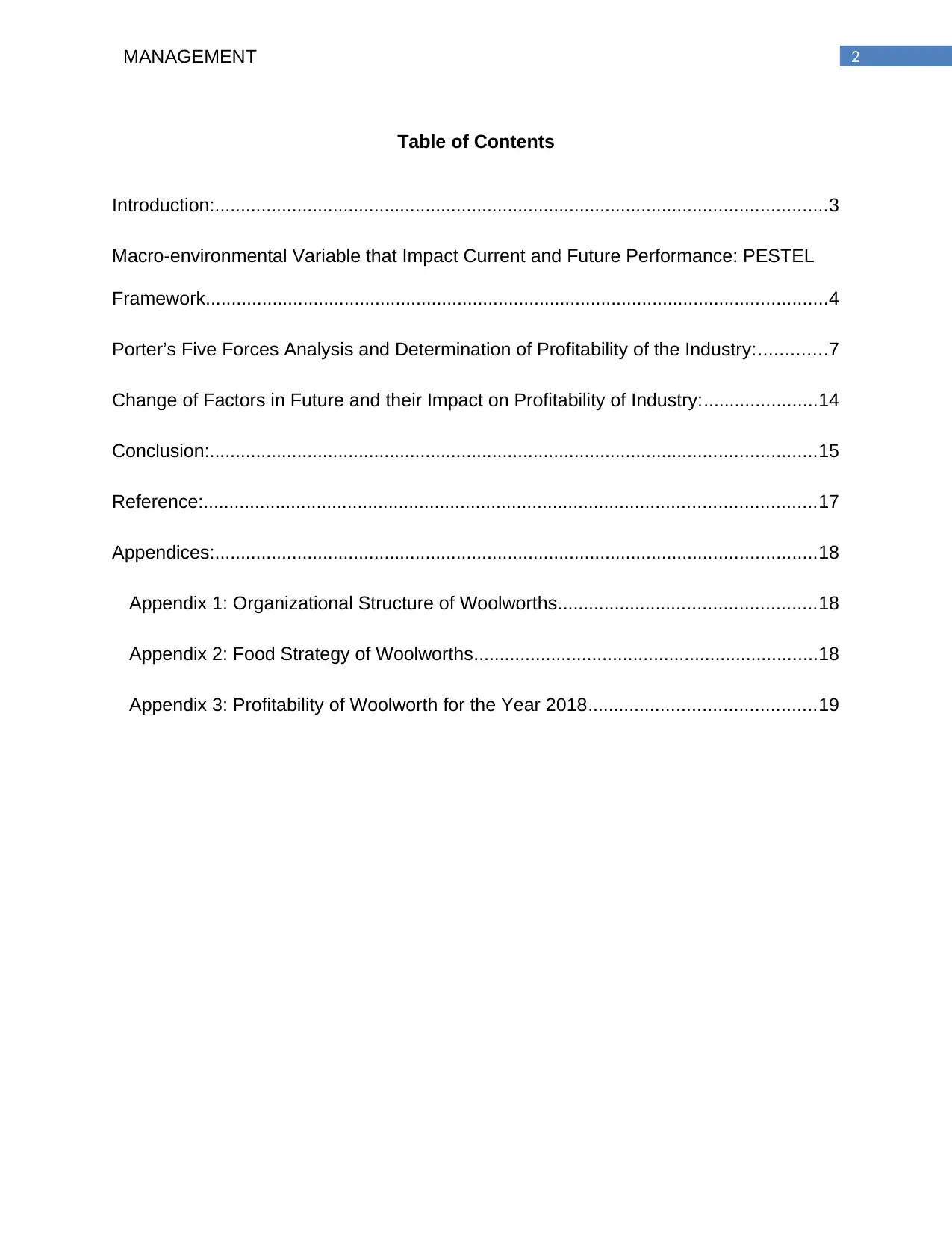
2MANAGEMENT
Table of Contents
Introduction:.......................................................................................................................3
Macro-environmental Variable that Impact Current and Future Performance: PESTEL
Framework.........................................................................................................................4
Porter’s Five Forces Analysis and Determination of Profitability of the Industry:.............7
Change of Factors in Future and their Impact on Profitability of Industry:......................14
Conclusion:......................................................................................................................15
Reference:.......................................................................................................................17
Appendices:.....................................................................................................................18
Appendix 1: Organizational Structure of Woolworths..................................................18
Appendix 2: Food Strategy of Woolworths...................................................................18
Appendix 3: Profitability of Woolworth for the Year 2018............................................19
Table of Contents
Introduction:.......................................................................................................................3
Macro-environmental Variable that Impact Current and Future Performance: PESTEL
Framework.........................................................................................................................4
Porter’s Five Forces Analysis and Determination of Profitability of the Industry:.............7
Change of Factors in Future and their Impact on Profitability of Industry:......................14
Conclusion:......................................................................................................................15
Reference:.......................................................................................................................17
Appendices:.....................................................................................................................18
Appendix 1: Organizational Structure of Woolworths..................................................18
Appendix 2: Food Strategy of Woolworths...................................................................18
Appendix 3: Profitability of Woolworth for the Year 2018............................................19
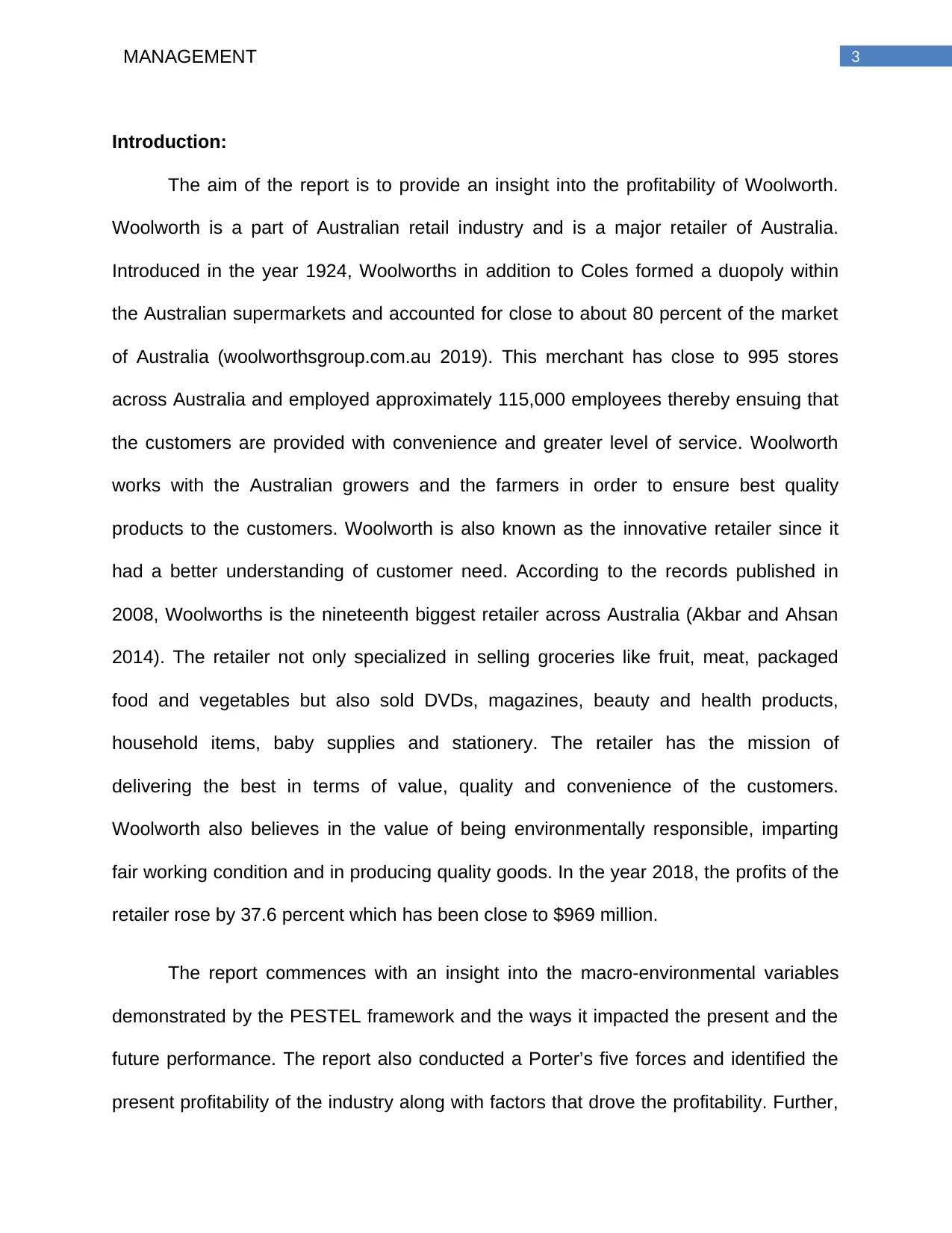
3MANAGEMENT
Introduction:
The aim of the report is to provide an insight into the profitability of Woolworth.
Woolworth is a part of Australian retail industry and is a major retailer of Australia.
Introduced in the year 1924, Woolworths in addition to Coles formed a duopoly within
the Australian supermarkets and accounted for close to about 80 percent of the market
of Australia (woolworthsgroup.com.au 2019). This merchant has close to 995 stores
across Australia and employed approximately 115,000 employees thereby ensuing that
the customers are provided with convenience and greater level of service. Woolworth
works with the Australian growers and the farmers in order to ensure best quality
products to the customers. Woolworth is also known as the innovative retailer since it
had a better understanding of customer need. According to the records published in
2008, Woolworths is the nineteenth biggest retailer across Australia (Akbar and Ahsan
2014). The retailer not only specialized in selling groceries like fruit, meat, packaged
food and vegetables but also sold DVDs, magazines, beauty and health products,
household items, baby supplies and stationery. The retailer has the mission of
delivering the best in terms of value, quality and convenience of the customers.
Woolworth also believes in the value of being environmentally responsible, imparting
fair working condition and in producing quality goods. In the year 2018, the profits of the
retailer rose by 37.6 percent which has been close to $969 million.
The report commences with an insight into the macro-environmental variables
demonstrated by the PESTEL framework and the ways it impacted the present and the
future performance. The report also conducted a Porter’s five forces and identified the
present profitability of the industry along with factors that drove the profitability. Further,
Introduction:
The aim of the report is to provide an insight into the profitability of Woolworth.
Woolworth is a part of Australian retail industry and is a major retailer of Australia.
Introduced in the year 1924, Woolworths in addition to Coles formed a duopoly within
the Australian supermarkets and accounted for close to about 80 percent of the market
of Australia (woolworthsgroup.com.au 2019). This merchant has close to 995 stores
across Australia and employed approximately 115,000 employees thereby ensuing that
the customers are provided with convenience and greater level of service. Woolworth
works with the Australian growers and the farmers in order to ensure best quality
products to the customers. Woolworth is also known as the innovative retailer since it
had a better understanding of customer need. According to the records published in
2008, Woolworths is the nineteenth biggest retailer across Australia (Akbar and Ahsan
2014). The retailer not only specialized in selling groceries like fruit, meat, packaged
food and vegetables but also sold DVDs, magazines, beauty and health products,
household items, baby supplies and stationery. The retailer has the mission of
delivering the best in terms of value, quality and convenience of the customers.
Woolworth also believes in the value of being environmentally responsible, imparting
fair working condition and in producing quality goods. In the year 2018, the profits of the
retailer rose by 37.6 percent which has been close to $969 million.
The report commences with an insight into the macro-environmental variables
demonstrated by the PESTEL framework and the ways it impacted the present and the
future performance. The report also conducted a Porter’s five forces and identified the
present profitability of the industry along with factors that drove the profitability. Further,
Secure Best Marks with AI Grader
Need help grading? Try our AI Grader for instant feedback on your assignments.
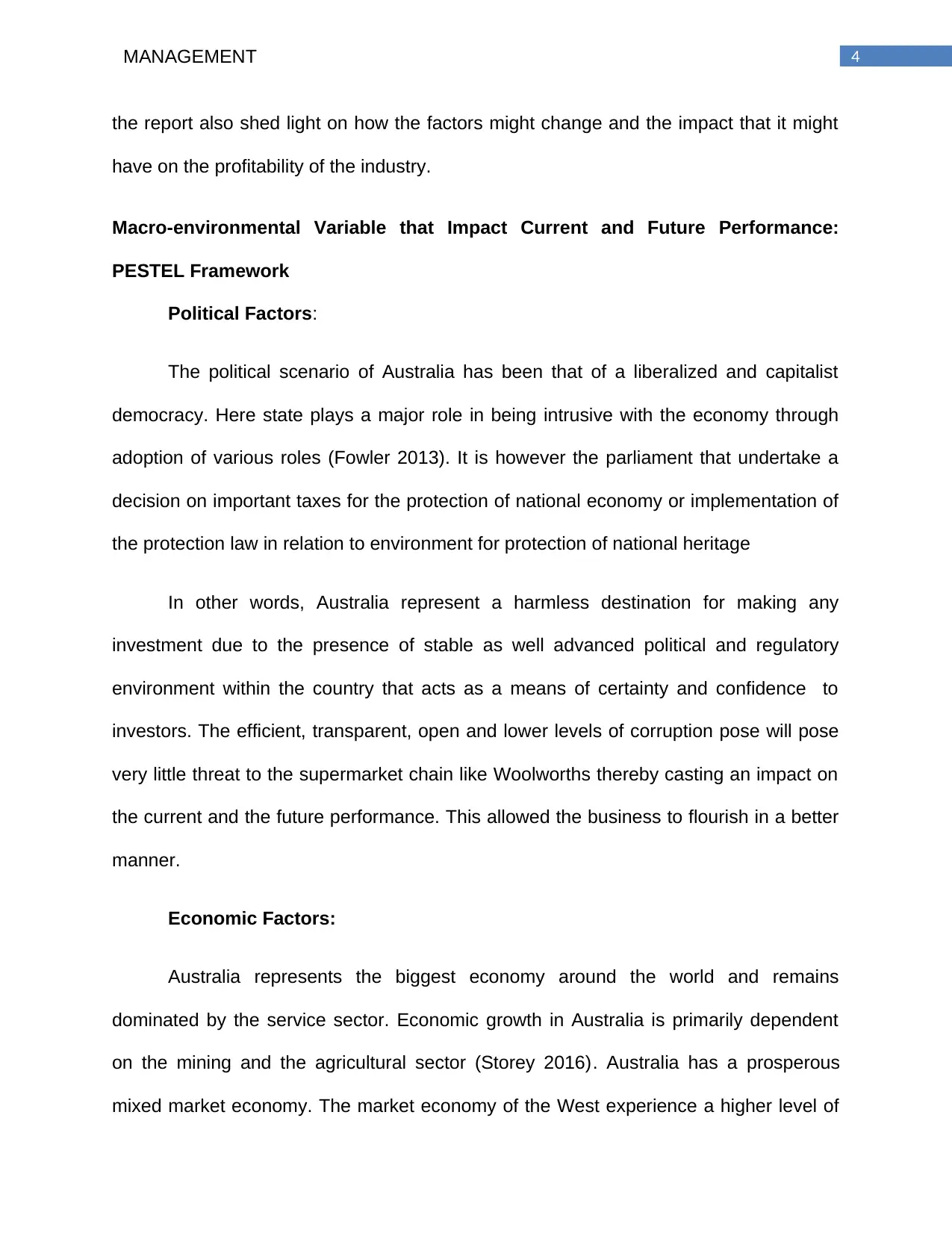
4MANAGEMENT
the report also shed light on how the factors might change and the impact that it might
have on the profitability of the industry.
Macro-environmental Variable that Impact Current and Future Performance:
PESTEL Framework
Political Factors:
The political scenario of Australia has been that of a liberalized and capitalist
democracy. Here state plays a major role in being intrusive with the economy through
adoption of various roles (Fowler 2013). It is however the parliament that undertake a
decision on important taxes for the protection of national economy or implementation of
the protection law in relation to environment for protection of national heritage
In other words, Australia represent a harmless destination for making any
investment due to the presence of stable as well advanced political and regulatory
environment within the country that acts as a means of certainty and confidence to
investors. The efficient, transparent, open and lower levels of corruption pose will pose
very little threat to the supermarket chain like Woolworths thereby casting an impact on
the current and the future performance. This allowed the business to flourish in a better
manner.
Economic Factors:
Australia represents the biggest economy around the world and remains
dominated by the service sector. Economic growth in Australia is primarily dependent
on the mining and the agricultural sector (Storey 2016). Australia has a prosperous
mixed market economy. The market economy of the West experience a higher level of
the report also shed light on how the factors might change and the impact that it might
have on the profitability of the industry.
Macro-environmental Variable that Impact Current and Future Performance:
PESTEL Framework
Political Factors:
The political scenario of Australia has been that of a liberalized and capitalist
democracy. Here state plays a major role in being intrusive with the economy through
adoption of various roles (Fowler 2013). It is however the parliament that undertake a
decision on important taxes for the protection of national economy or implementation of
the protection law in relation to environment for protection of national heritage
In other words, Australia represent a harmless destination for making any
investment due to the presence of stable as well advanced political and regulatory
environment within the country that acts as a means of certainty and confidence to
investors. The efficient, transparent, open and lower levels of corruption pose will pose
very little threat to the supermarket chain like Woolworths thereby casting an impact on
the current and the future performance. This allowed the business to flourish in a better
manner.
Economic Factors:
Australia represents the biggest economy around the world and remains
dominated by the service sector. Economic growth in Australia is primarily dependent
on the mining and the agricultural sector (Storey 2016). Australia has a prosperous
mixed market economy. The market economy of the West experience a higher level of
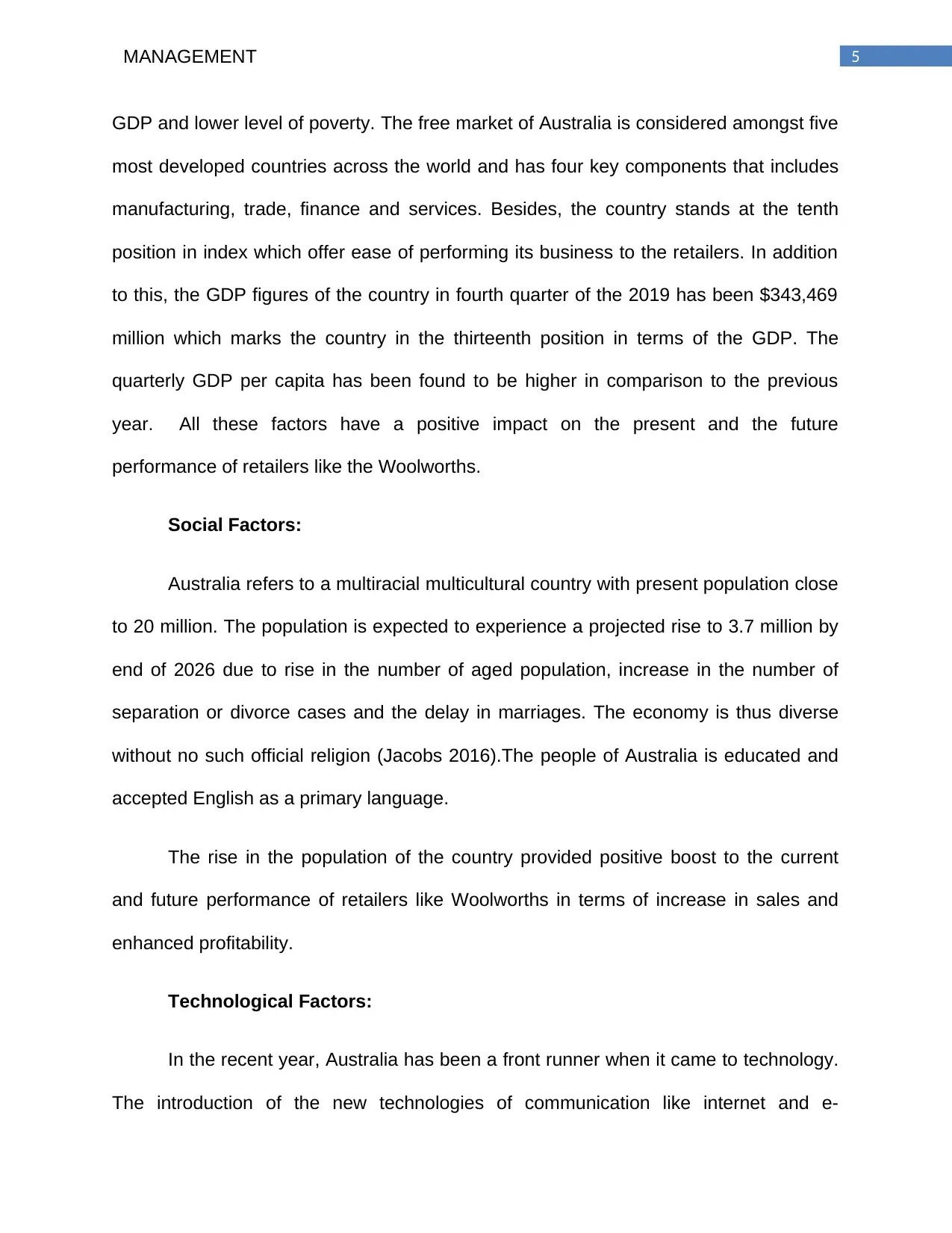
5MANAGEMENT
GDP and lower level of poverty. The free market of Australia is considered amongst five
most developed countries across the world and has four key components that includes
manufacturing, trade, finance and services. Besides, the country stands at the tenth
position in index which offer ease of performing its business to the retailers. In addition
to this, the GDP figures of the country in fourth quarter of the 2019 has been $343,469
million which marks the country in the thirteenth position in terms of the GDP. The
quarterly GDP per capita has been found to be higher in comparison to the previous
year. All these factors have a positive impact on the present and the future
performance of retailers like the Woolworths.
Social Factors:
Australia refers to a multiracial multicultural country with present population close
to 20 million. The population is expected to experience a projected rise to 3.7 million by
end of 2026 due to rise in the number of aged population, increase in the number of
separation or divorce cases and the delay in marriages. The economy is thus diverse
without no such official religion (Jacobs 2016).The people of Australia is educated and
accepted English as a primary language.
The rise in the population of the country provided positive boost to the current
and future performance of retailers like Woolworths in terms of increase in sales and
enhanced profitability.
Technological Factors:
In the recent year, Australia has been a front runner when it came to technology.
The introduction of the new technologies of communication like internet and e-
GDP and lower level of poverty. The free market of Australia is considered amongst five
most developed countries across the world and has four key components that includes
manufacturing, trade, finance and services. Besides, the country stands at the tenth
position in index which offer ease of performing its business to the retailers. In addition
to this, the GDP figures of the country in fourth quarter of the 2019 has been $343,469
million which marks the country in the thirteenth position in terms of the GDP. The
quarterly GDP per capita has been found to be higher in comparison to the previous
year. All these factors have a positive impact on the present and the future
performance of retailers like the Woolworths.
Social Factors:
Australia refers to a multiracial multicultural country with present population close
to 20 million. The population is expected to experience a projected rise to 3.7 million by
end of 2026 due to rise in the number of aged population, increase in the number of
separation or divorce cases and the delay in marriages. The economy is thus diverse
without no such official religion (Jacobs 2016).The people of Australia is educated and
accepted English as a primary language.
The rise in the population of the country provided positive boost to the current
and future performance of retailers like Woolworths in terms of increase in sales and
enhanced profitability.
Technological Factors:
In the recent year, Australia has been a front runner when it came to technology.
The introduction of the new technologies of communication like internet and e-
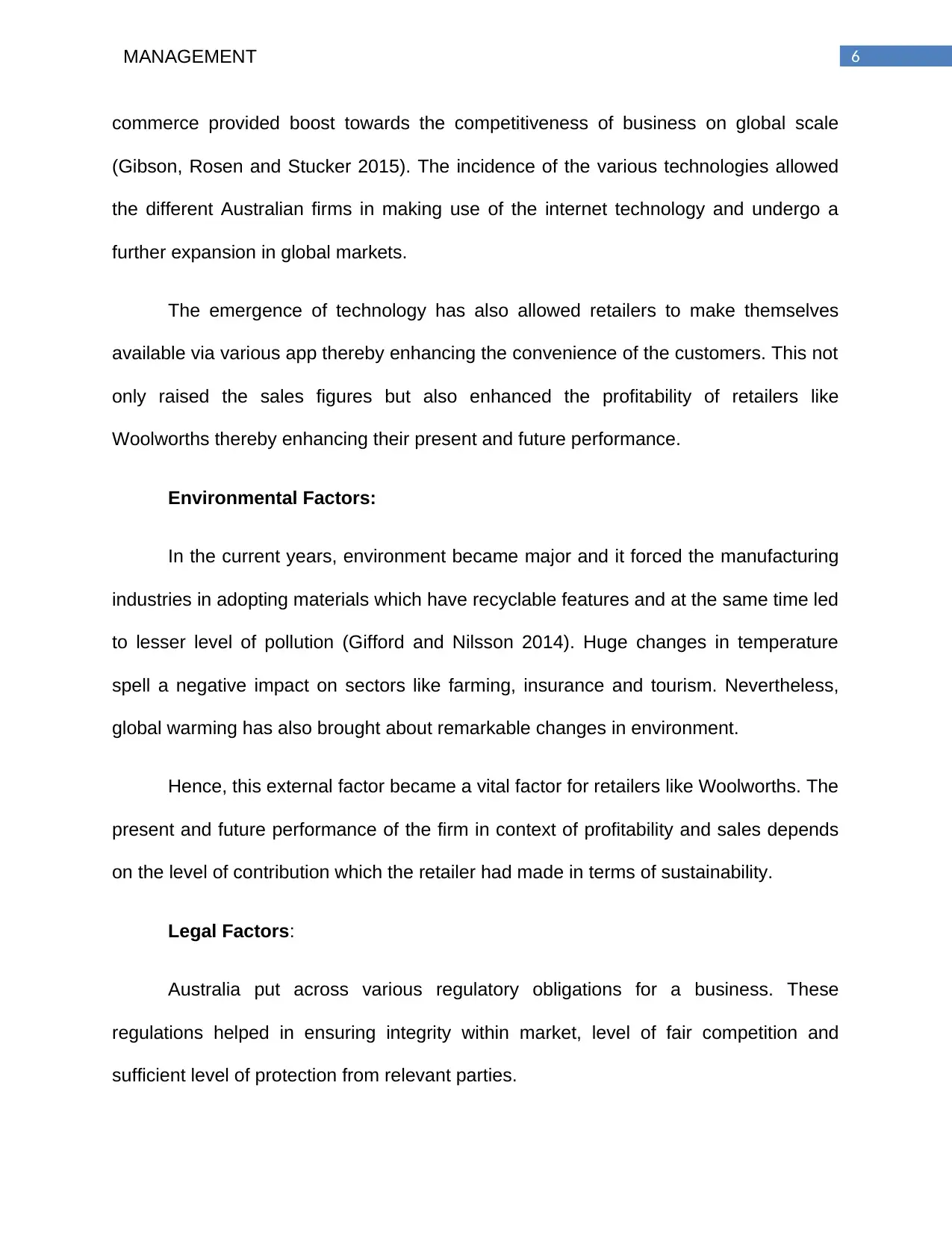
6MANAGEMENT
commerce provided boost towards the competitiveness of business on global scale
(Gibson, Rosen and Stucker 2015). The incidence of the various technologies allowed
the different Australian firms in making use of the internet technology and undergo a
further expansion in global markets.
The emergence of technology has also allowed retailers to make themselves
available via various app thereby enhancing the convenience of the customers. This not
only raised the sales figures but also enhanced the profitability of retailers like
Woolworths thereby enhancing their present and future performance.
Environmental Factors:
In the current years, environment became major and it forced the manufacturing
industries in adopting materials which have recyclable features and at the same time led
to lesser level of pollution (Gifford and Nilsson 2014). Huge changes in temperature
spell a negative impact on sectors like farming, insurance and tourism. Nevertheless,
global warming has also brought about remarkable changes in environment.
Hence, this external factor became a vital factor for retailers like Woolworths. The
present and future performance of the firm in context of profitability and sales depends
on the level of contribution which the retailer had made in terms of sustainability.
Legal Factors:
Australia put across various regulatory obligations for a business. These
regulations helped in ensuring integrity within market, level of fair competition and
sufficient level of protection from relevant parties.
commerce provided boost towards the competitiveness of business on global scale
(Gibson, Rosen and Stucker 2015). The incidence of the various technologies allowed
the different Australian firms in making use of the internet technology and undergo a
further expansion in global markets.
The emergence of technology has also allowed retailers to make themselves
available via various app thereby enhancing the convenience of the customers. This not
only raised the sales figures but also enhanced the profitability of retailers like
Woolworths thereby enhancing their present and future performance.
Environmental Factors:
In the current years, environment became major and it forced the manufacturing
industries in adopting materials which have recyclable features and at the same time led
to lesser level of pollution (Gifford and Nilsson 2014). Huge changes in temperature
spell a negative impact on sectors like farming, insurance and tourism. Nevertheless,
global warming has also brought about remarkable changes in environment.
Hence, this external factor became a vital factor for retailers like Woolworths. The
present and future performance of the firm in context of profitability and sales depends
on the level of contribution which the retailer had made in terms of sustainability.
Legal Factors:
Australia put across various regulatory obligations for a business. These
regulations helped in ensuring integrity within market, level of fair competition and
sufficient level of protection from relevant parties.
Paraphrase This Document
Need a fresh take? Get an instant paraphrase of this document with our AI Paraphraser
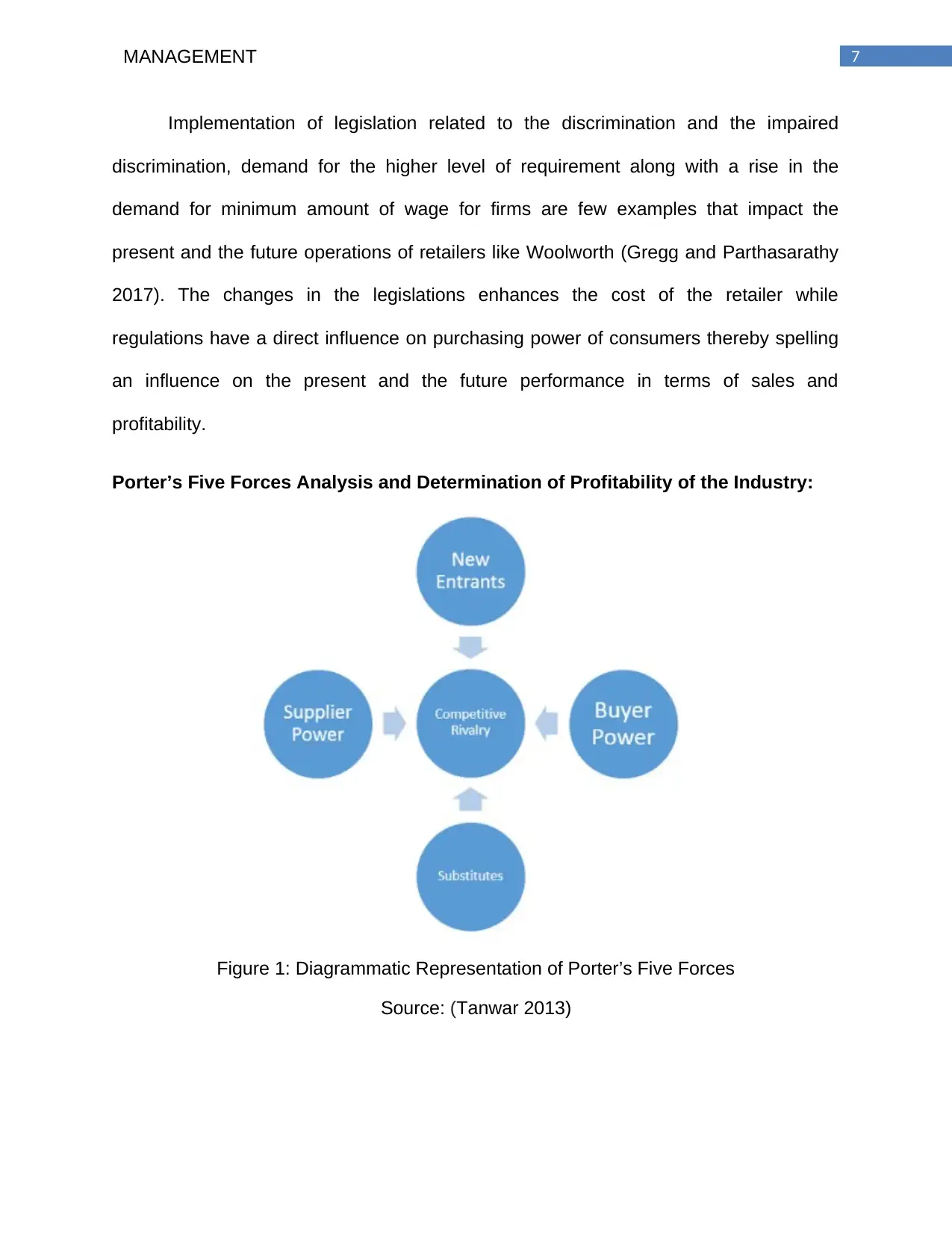
7MANAGEMENT
Implementation of legislation related to the discrimination and the impaired
discrimination, demand for the higher level of requirement along with a rise in the
demand for minimum amount of wage for firms are few examples that impact the
present and the future operations of retailers like Woolworth (Gregg and Parthasarathy
2017). The changes in the legislations enhances the cost of the retailer while
regulations have a direct influence on purchasing power of consumers thereby spelling
an influence on the present and the future performance in terms of sales and
profitability.
Porter’s Five Forces Analysis and Determination of Profitability of the Industry:
Figure 1: Diagrammatic Representation of Porter’s Five Forces
Source: (Tanwar 2013)
Implementation of legislation related to the discrimination and the impaired
discrimination, demand for the higher level of requirement along with a rise in the
demand for minimum amount of wage for firms are few examples that impact the
present and the future operations of retailers like Woolworth (Gregg and Parthasarathy
2017). The changes in the legislations enhances the cost of the retailer while
regulations have a direct influence on purchasing power of consumers thereby spelling
an influence on the present and the future performance in terms of sales and
profitability.
Porter’s Five Forces Analysis and Determination of Profitability of the Industry:
Figure 1: Diagrammatic Representation of Porter’s Five Forces
Source: (Tanwar 2013)
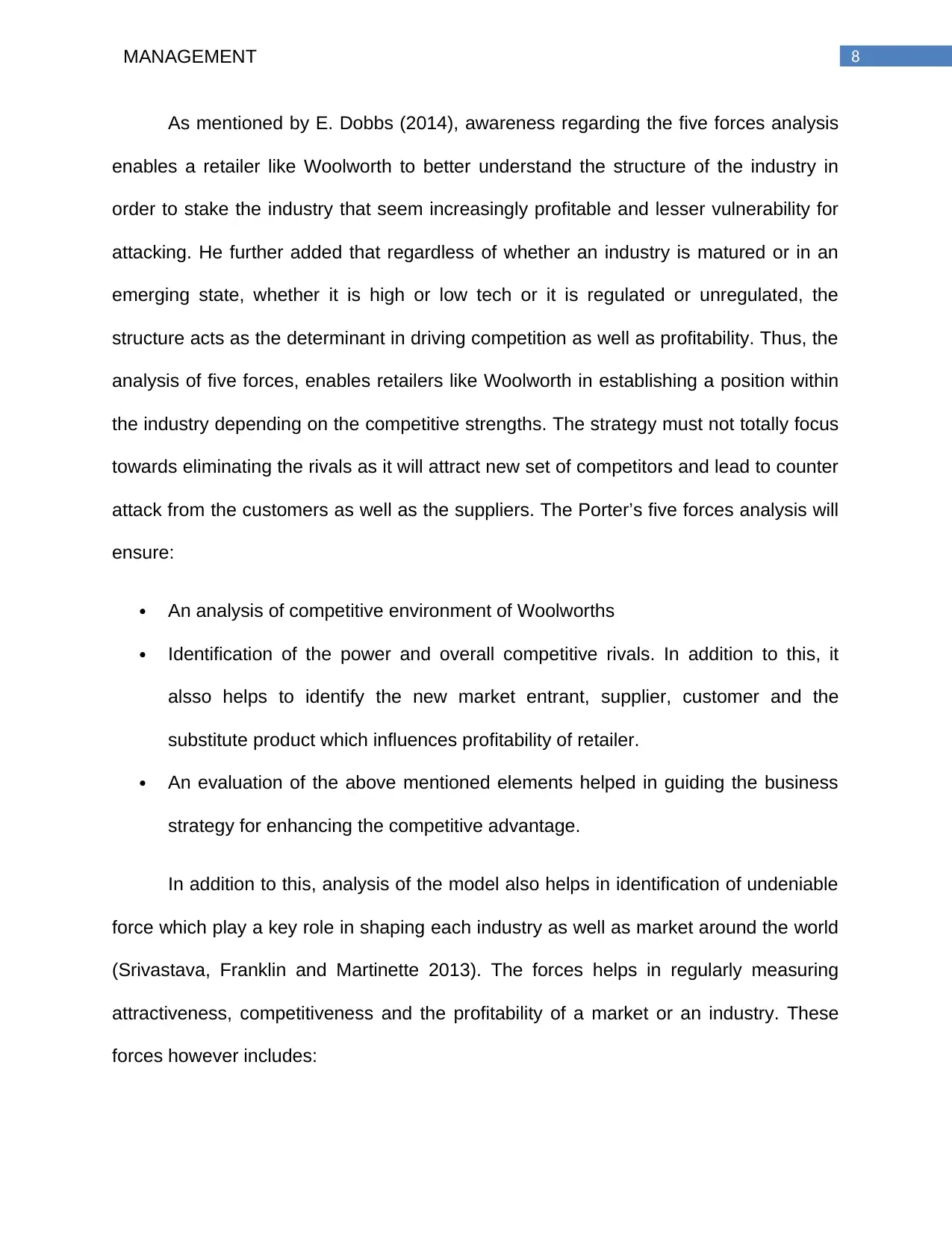
8MANAGEMENT
As mentioned by E. Dobbs (2014), awareness regarding the five forces analysis
enables a retailer like Woolworth to better understand the structure of the industry in
order to stake the industry that seem increasingly profitable and lesser vulnerability for
attacking. He further added that regardless of whether an industry is matured or in an
emerging state, whether it is high or low tech or it is regulated or unregulated, the
structure acts as the determinant in driving competition as well as profitability. Thus, the
analysis of five forces, enables retailers like Woolworth in establishing a position within
the industry depending on the competitive strengths. The strategy must not totally focus
towards eliminating the rivals as it will attract new set of competitors and lead to counter
attack from the customers as well as the suppliers. The Porter’s five forces analysis will
ensure:
An analysis of competitive environment of Woolworths
Identification of the power and overall competitive rivals. In addition to this, it
alsso helps to identify the new market entrant, supplier, customer and the
substitute product which influences profitability of retailer.
An evaluation of the above mentioned elements helped in guiding the business
strategy for enhancing the competitive advantage.
In addition to this, analysis of the model also helps in identification of undeniable
force which play a key role in shaping each industry as well as market around the world
(Srivastava, Franklin and Martinette 2013). The forces helps in regularly measuring
attractiveness, competitiveness and the profitability of a market or an industry. These
forces however includes:
As mentioned by E. Dobbs (2014), awareness regarding the five forces analysis
enables a retailer like Woolworth to better understand the structure of the industry in
order to stake the industry that seem increasingly profitable and lesser vulnerability for
attacking. He further added that regardless of whether an industry is matured or in an
emerging state, whether it is high or low tech or it is regulated or unregulated, the
structure acts as the determinant in driving competition as well as profitability. Thus, the
analysis of five forces, enables retailers like Woolworth in establishing a position within
the industry depending on the competitive strengths. The strategy must not totally focus
towards eliminating the rivals as it will attract new set of competitors and lead to counter
attack from the customers as well as the suppliers. The Porter’s five forces analysis will
ensure:
An analysis of competitive environment of Woolworths
Identification of the power and overall competitive rivals. In addition to this, it
alsso helps to identify the new market entrant, supplier, customer and the
substitute product which influences profitability of retailer.
An evaluation of the above mentioned elements helped in guiding the business
strategy for enhancing the competitive advantage.
In addition to this, analysis of the model also helps in identification of undeniable
force which play a key role in shaping each industry as well as market around the world
(Srivastava, Franklin and Martinette 2013). The forces helps in regularly measuring
attractiveness, competitiveness and the profitability of a market or an industry. These
forces however includes:
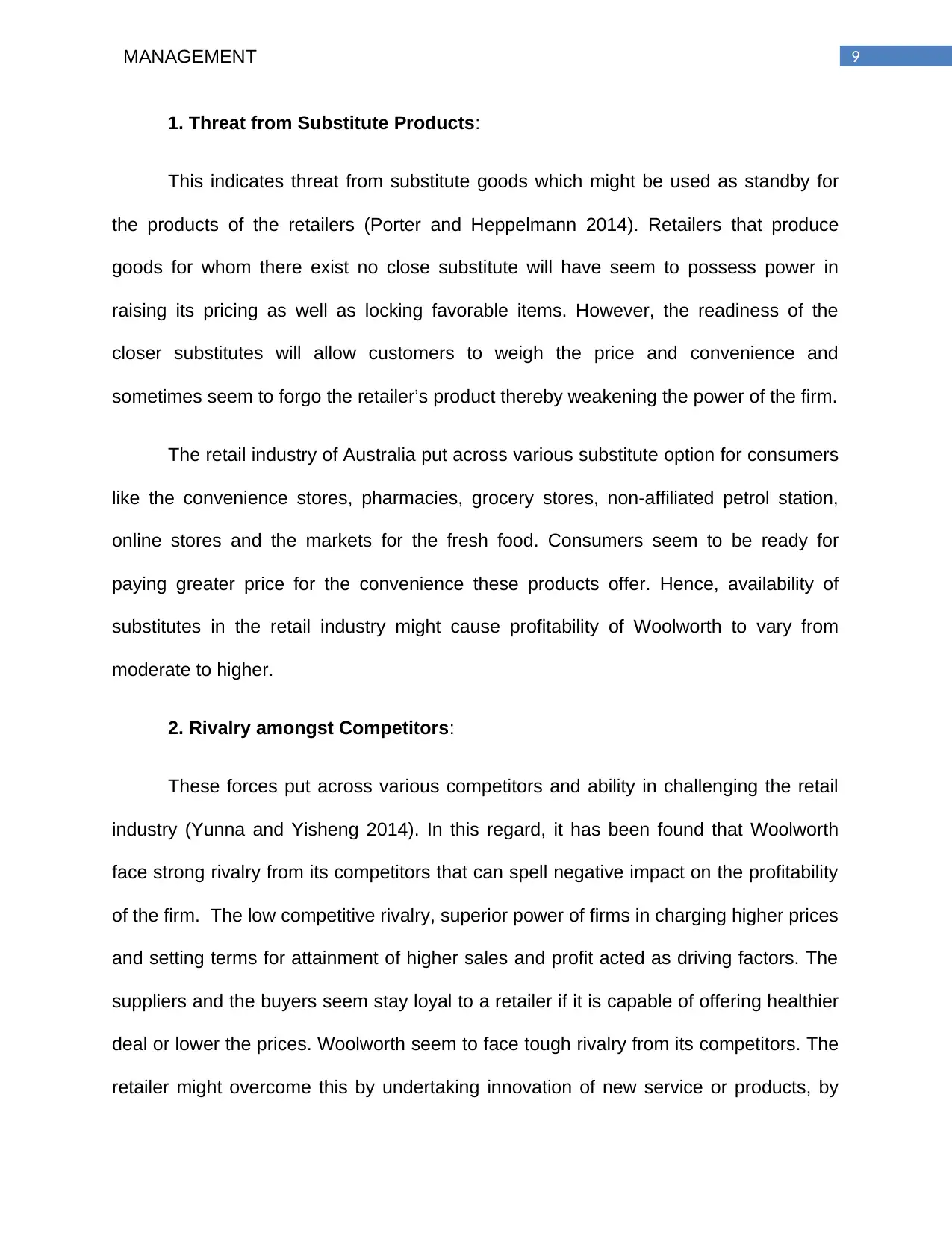
9MANAGEMENT
1. Threat from Substitute Products:
This indicates threat from substitute goods which might be used as standby for
the products of the retailers (Porter and Heppelmann 2014). Retailers that produce
goods for whom there exist no close substitute will have seem to possess power in
raising its pricing as well as locking favorable items. However, the readiness of the
closer substitutes will allow customers to weigh the price and convenience and
sometimes seem to forgo the retailer’s product thereby weakening the power of the firm.
The retail industry of Australia put across various substitute option for consumers
like the convenience stores, pharmacies, grocery stores, non-affiliated petrol station,
online stores and the markets for the fresh food. Consumers seem to be ready for
paying greater price for the convenience these products offer. Hence, availability of
substitutes in the retail industry might cause profitability of Woolworth to vary from
moderate to higher.
2. Rivalry amongst Competitors:
These forces put across various competitors and ability in challenging the retail
industry (Yunna and Yisheng 2014). In this regard, it has been found that Woolworth
face strong rivalry from its competitors that can spell negative impact on the profitability
of the firm. The low competitive rivalry, superior power of firms in charging higher prices
and setting terms for attainment of higher sales and profit acted as driving factors. The
suppliers and the buyers seem stay loyal to a retailer if it is capable of offering healthier
deal or lower the prices. Woolworth seem to face tough rivalry from its competitors. The
retailer might overcome this by undertaking innovation of new service or products, by
1. Threat from Substitute Products:
This indicates threat from substitute goods which might be used as standby for
the products of the retailers (Porter and Heppelmann 2014). Retailers that produce
goods for whom there exist no close substitute will have seem to possess power in
raising its pricing as well as locking favorable items. However, the readiness of the
closer substitutes will allow customers to weigh the price and convenience and
sometimes seem to forgo the retailer’s product thereby weakening the power of the firm.
The retail industry of Australia put across various substitute option for consumers
like the convenience stores, pharmacies, grocery stores, non-affiliated petrol station,
online stores and the markets for the fresh food. Consumers seem to be ready for
paying greater price for the convenience these products offer. Hence, availability of
substitutes in the retail industry might cause profitability of Woolworth to vary from
moderate to higher.
2. Rivalry amongst Competitors:
These forces put across various competitors and ability in challenging the retail
industry (Yunna and Yisheng 2014). In this regard, it has been found that Woolworth
face strong rivalry from its competitors that can spell negative impact on the profitability
of the firm. The low competitive rivalry, superior power of firms in charging higher prices
and setting terms for attainment of higher sales and profit acted as driving factors. The
suppliers and the buyers seem stay loyal to a retailer if it is capable of offering healthier
deal or lower the prices. Woolworth seem to face tough rivalry from its competitors. The
retailer might overcome this by undertaking innovation of new service or products, by
Secure Best Marks with AI Grader
Need help grading? Try our AI Grader for instant feedback on your assignments.
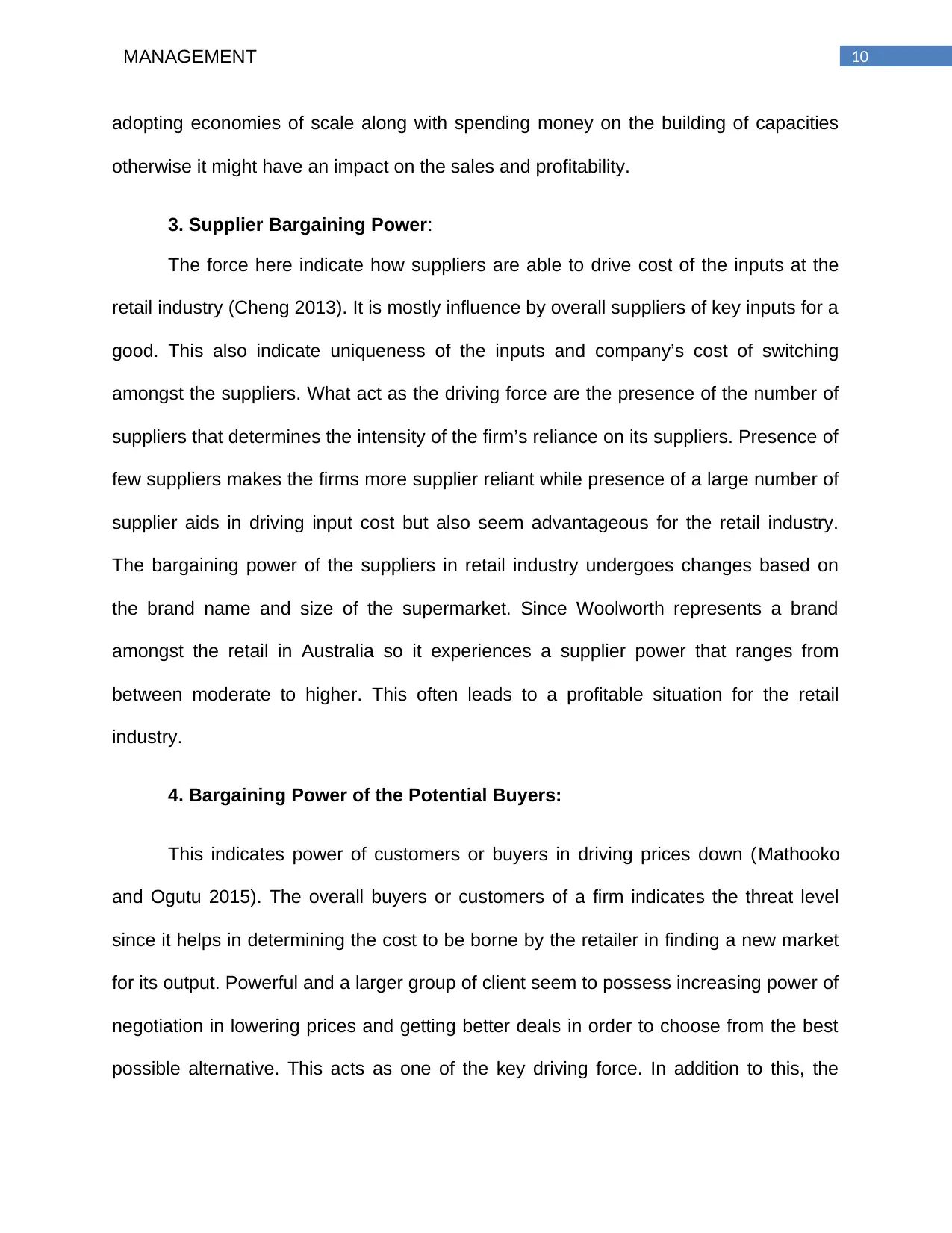
10MANAGEMENT
adopting economies of scale along with spending money on the building of capacities
otherwise it might have an impact on the sales and profitability.
3. Supplier Bargaining Power:
The force here indicate how suppliers are able to drive cost of the inputs at the
retail industry (Cheng 2013). It is mostly influence by overall suppliers of key inputs for a
good. This also indicate uniqueness of the inputs and company’s cost of switching
amongst the suppliers. What act as the driving force are the presence of the number of
suppliers that determines the intensity of the firm’s reliance on its suppliers. Presence of
few suppliers makes the firms more supplier reliant while presence of a large number of
supplier aids in driving input cost but also seem advantageous for the retail industry.
The bargaining power of the suppliers in retail industry undergoes changes based on
the brand name and size of the supermarket. Since Woolworth represents a brand
amongst the retail in Australia so it experiences a supplier power that ranges from
between moderate to higher. This often leads to a profitable situation for the retail
industry.
4. Bargaining Power of the Potential Buyers:
This indicates power of customers or buyers in driving prices down (Mathooko
and Ogutu 2015). The overall buyers or customers of a firm indicates the threat level
since it helps in determining the cost to be borne by the retailer in finding a new market
for its output. Powerful and a larger group of client seem to possess increasing power of
negotiation in lowering prices and getting better deals in order to choose from the best
possible alternative. This acts as one of the key driving force. In addition to this, the
adopting economies of scale along with spending money on the building of capacities
otherwise it might have an impact on the sales and profitability.
3. Supplier Bargaining Power:
The force here indicate how suppliers are able to drive cost of the inputs at the
retail industry (Cheng 2013). It is mostly influence by overall suppliers of key inputs for a
good. This also indicate uniqueness of the inputs and company’s cost of switching
amongst the suppliers. What act as the driving force are the presence of the number of
suppliers that determines the intensity of the firm’s reliance on its suppliers. Presence of
few suppliers makes the firms more supplier reliant while presence of a large number of
supplier aids in driving input cost but also seem advantageous for the retail industry.
The bargaining power of the suppliers in retail industry undergoes changes based on
the brand name and size of the supermarket. Since Woolworth represents a brand
amongst the retail in Australia so it experiences a supplier power that ranges from
between moderate to higher. This often leads to a profitable situation for the retail
industry.
4. Bargaining Power of the Potential Buyers:
This indicates power of customers or buyers in driving prices down (Mathooko
and Ogutu 2015). The overall buyers or customers of a firm indicates the threat level
since it helps in determining the cost to be borne by the retailer in finding a new market
for its output. Powerful and a larger group of client seem to possess increasing power of
negotiation in lowering prices and getting better deals in order to choose from the best
possible alternative. This acts as one of the key driving force. In addition to this, the
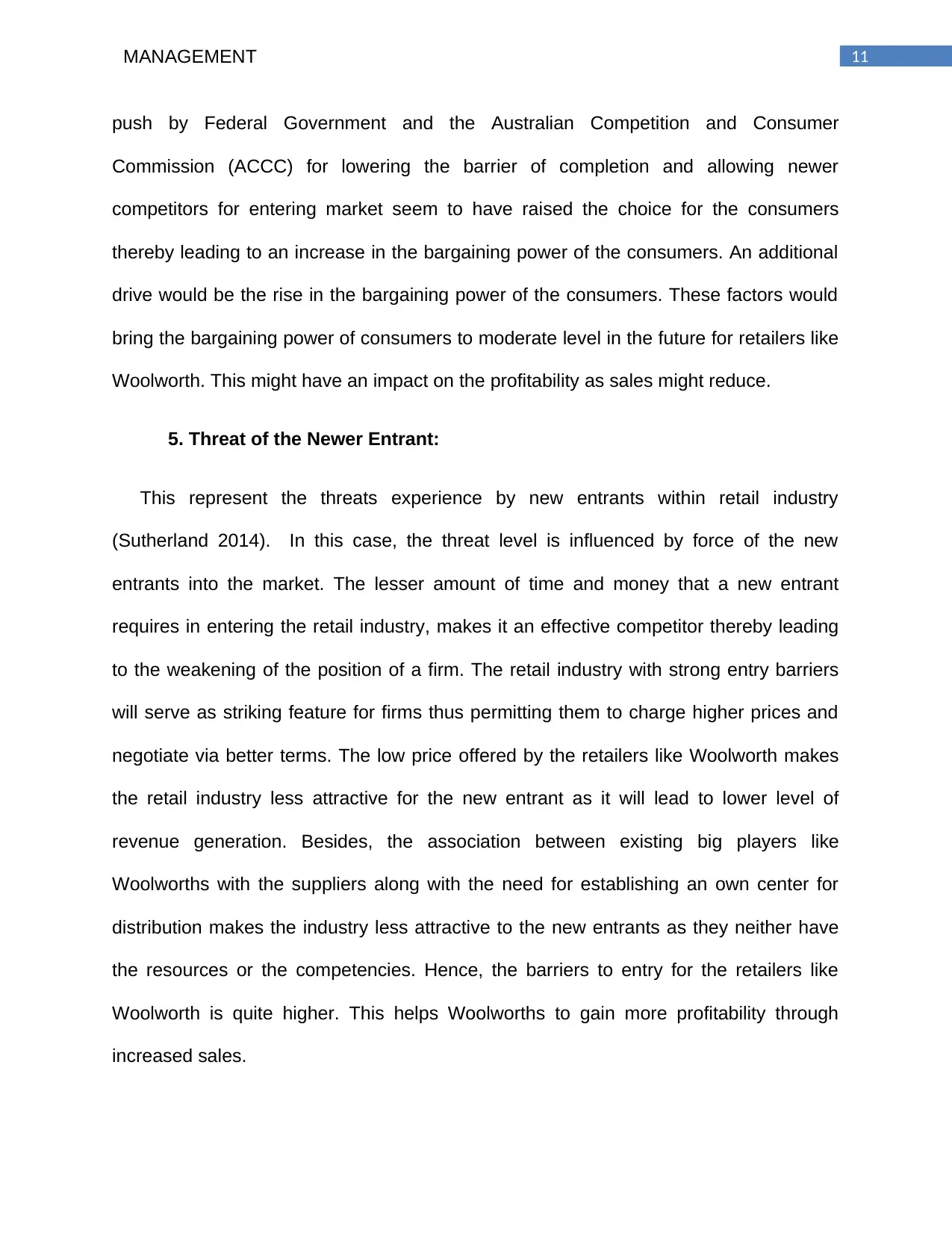
11MANAGEMENT
push by Federal Government and the Australian Competition and Consumer
Commission (ACCC) for lowering the barrier of completion and allowing newer
competitors for entering market seem to have raised the choice for the consumers
thereby leading to an increase in the bargaining power of the consumers. An additional
drive would be the rise in the bargaining power of the consumers. These factors would
bring the bargaining power of consumers to moderate level in the future for retailers like
Woolworth. This might have an impact on the profitability as sales might reduce.
5. Threat of the Newer Entrant:
This represent the threats experience by new entrants within retail industry
(Sutherland 2014). In this case, the threat level is influenced by force of the new
entrants into the market. The lesser amount of time and money that a new entrant
requires in entering the retail industry, makes it an effective competitor thereby leading
to the weakening of the position of a firm. The retail industry with strong entry barriers
will serve as striking feature for firms thus permitting them to charge higher prices and
negotiate via better terms. The low price offered by the retailers like Woolworth makes
the retail industry less attractive for the new entrant as it will lead to lower level of
revenue generation. Besides, the association between existing big players like
Woolworths with the suppliers along with the need for establishing an own center for
distribution makes the industry less attractive to the new entrants as they neither have
the resources or the competencies. Hence, the barriers to entry for the retailers like
Woolworth is quite higher. This helps Woolworths to gain more profitability through
increased sales.
push by Federal Government and the Australian Competition and Consumer
Commission (ACCC) for lowering the barrier of completion and allowing newer
competitors for entering market seem to have raised the choice for the consumers
thereby leading to an increase in the bargaining power of the consumers. An additional
drive would be the rise in the bargaining power of the consumers. These factors would
bring the bargaining power of consumers to moderate level in the future for retailers like
Woolworth. This might have an impact on the profitability as sales might reduce.
5. Threat of the Newer Entrant:
This represent the threats experience by new entrants within retail industry
(Sutherland 2014). In this case, the threat level is influenced by force of the new
entrants into the market. The lesser amount of time and money that a new entrant
requires in entering the retail industry, makes it an effective competitor thereby leading
to the weakening of the position of a firm. The retail industry with strong entry barriers
will serve as striking feature for firms thus permitting them to charge higher prices and
negotiate via better terms. The low price offered by the retailers like Woolworth makes
the retail industry less attractive for the new entrant as it will lead to lower level of
revenue generation. Besides, the association between existing big players like
Woolworths with the suppliers along with the need for establishing an own center for
distribution makes the industry less attractive to the new entrants as they neither have
the resources or the competencies. Hence, the barriers to entry for the retailers like
Woolworth is quite higher. This helps Woolworths to gain more profitability through
increased sales.
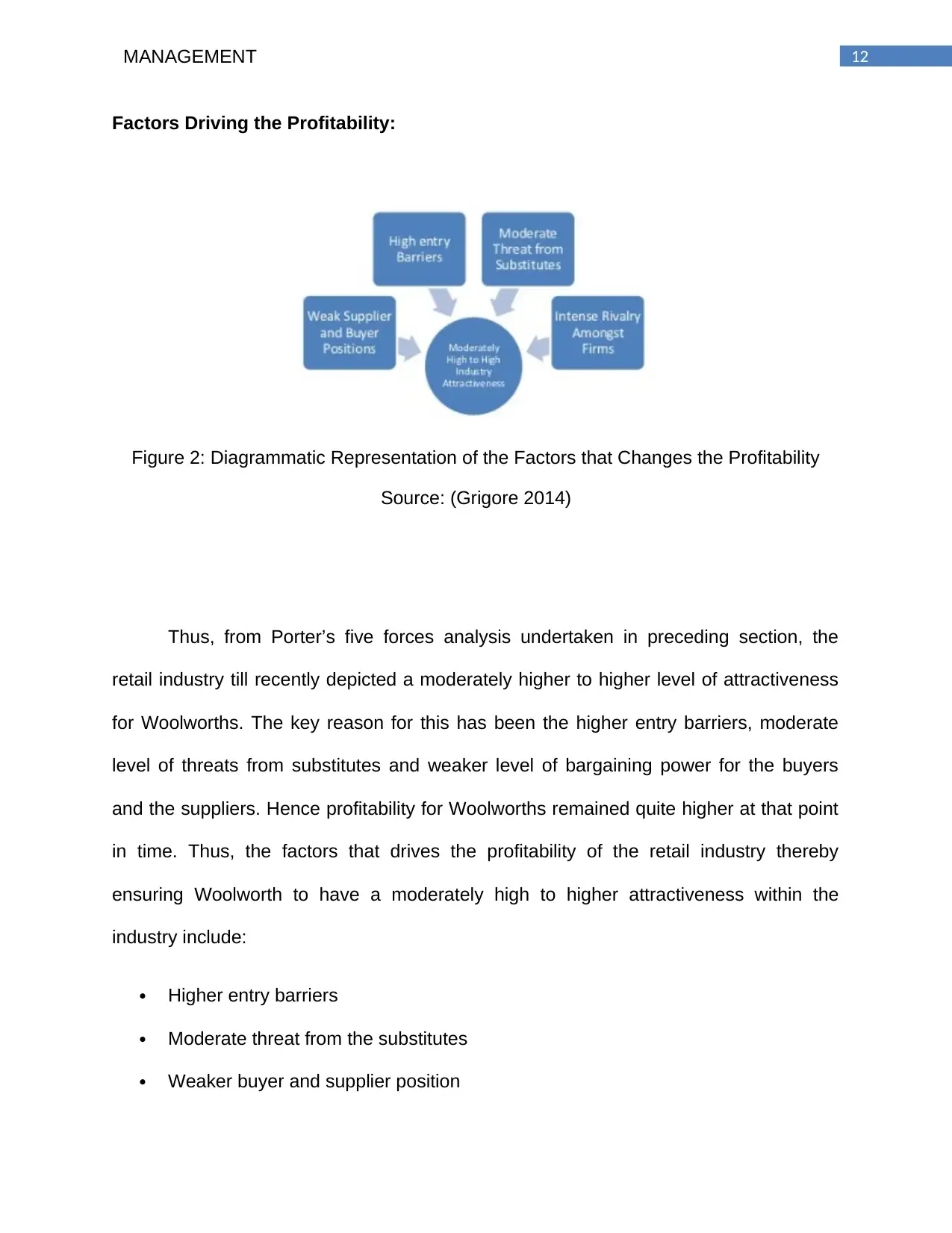
12MANAGEMENT
Factors Driving the Profitability:
Figure 2: Diagrammatic Representation of the Factors that Changes the Profitability
Source: (Grigore 2014)
Thus, from Porter’s five forces analysis undertaken in preceding section, the
retail industry till recently depicted a moderately higher to higher level of attractiveness
for Woolworths. The key reason for this has been the higher entry barriers, moderate
level of threats from substitutes and weaker level of bargaining power for the buyers
and the suppliers. Hence profitability for Woolworths remained quite higher at that point
in time. Thus, the factors that drives the profitability of the retail industry thereby
ensuring Woolworth to have a moderately high to higher attractiveness within the
industry include:
Higher entry barriers
Moderate threat from the substitutes
Weaker buyer and supplier position
Factors Driving the Profitability:
Figure 2: Diagrammatic Representation of the Factors that Changes the Profitability
Source: (Grigore 2014)
Thus, from Porter’s five forces analysis undertaken in preceding section, the
retail industry till recently depicted a moderately higher to higher level of attractiveness
for Woolworths. The key reason for this has been the higher entry barriers, moderate
level of threats from substitutes and weaker level of bargaining power for the buyers
and the suppliers. Hence profitability for Woolworths remained quite higher at that point
in time. Thus, the factors that drives the profitability of the retail industry thereby
ensuring Woolworth to have a moderately high to higher attractiveness within the
industry include:
Higher entry barriers
Moderate threat from the substitutes
Weaker buyer and supplier position
Paraphrase This Document
Need a fresh take? Get an instant paraphrase of this document with our AI Paraphraser
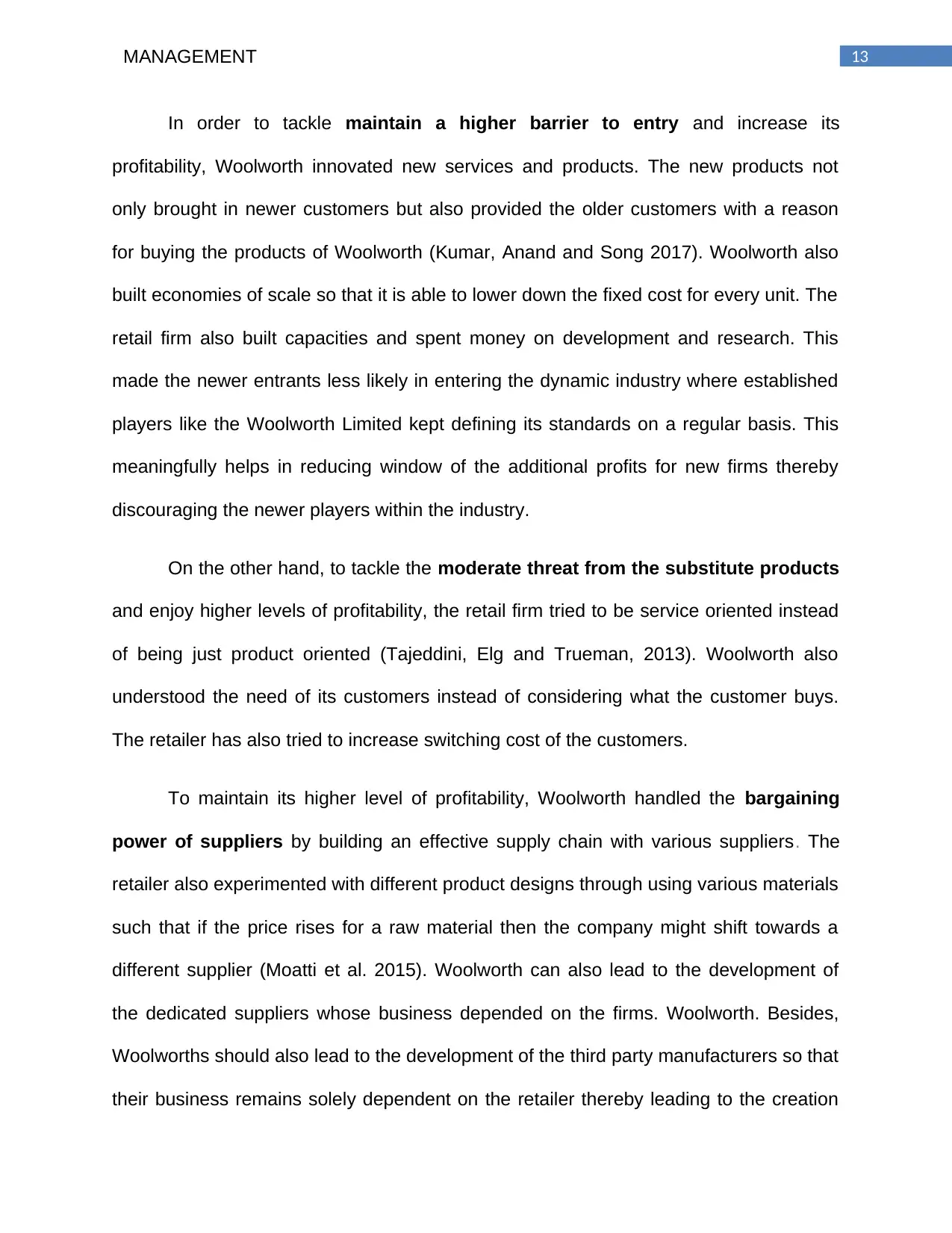
13MANAGEMENT
In order to tackle maintain a higher barrier to entry and increase its
profitability, Woolworth innovated new services and products. The new products not
only brought in newer customers but also provided the older customers with a reason
for buying the products of Woolworth (Kumar, Anand and Song 2017). Woolworth also
built economies of scale so that it is able to lower down the fixed cost for every unit. The
retail firm also built capacities and spent money on development and research. This
made the newer entrants less likely in entering the dynamic industry where established
players like the Woolworth Limited kept defining its standards on a regular basis. This
meaningfully helps in reducing window of the additional profits for new firms thereby
discouraging the newer players within the industry.
On the other hand, to tackle the moderate threat from the substitute products
and enjoy higher levels of profitability, the retail firm tried to be service oriented instead
of being just product oriented (Tajeddini, Elg and Trueman, 2013). Woolworth also
understood the need of its customers instead of considering what the customer buys.
The retailer has also tried to increase switching cost of the customers.
To maintain its higher level of profitability, Woolworth handled the bargaining
power of suppliers by building an effective supply chain with various suppliers. The
retailer also experimented with different product designs through using various materials
such that if the price rises for a raw material then the company might shift towards a
different supplier (Moatti et al. 2015). Woolworth can also lead to the development of
the dedicated suppliers whose business depended on the firms. Woolworth. Besides,
Woolworths should also lead to the development of the third party manufacturers so that
their business remains solely dependent on the retailer thereby leading to the creation
In order to tackle maintain a higher barrier to entry and increase its
profitability, Woolworth innovated new services and products. The new products not
only brought in newer customers but also provided the older customers with a reason
for buying the products of Woolworth (Kumar, Anand and Song 2017). Woolworth also
built economies of scale so that it is able to lower down the fixed cost for every unit. The
retail firm also built capacities and spent money on development and research. This
made the newer entrants less likely in entering the dynamic industry where established
players like the Woolworth Limited kept defining its standards on a regular basis. This
meaningfully helps in reducing window of the additional profits for new firms thereby
discouraging the newer players within the industry.
On the other hand, to tackle the moderate threat from the substitute products
and enjoy higher levels of profitability, the retail firm tried to be service oriented instead
of being just product oriented (Tajeddini, Elg and Trueman, 2013). Woolworth also
understood the need of its customers instead of considering what the customer buys.
The retailer has also tried to increase switching cost of the customers.
To maintain its higher level of profitability, Woolworth handled the bargaining
power of suppliers by building an effective supply chain with various suppliers. The
retailer also experimented with different product designs through using various materials
such that if the price rises for a raw material then the company might shift towards a
different supplier (Moatti et al. 2015). Woolworth can also lead to the development of
the dedicated suppliers whose business depended on the firms. Woolworth. Besides,
Woolworths should also lead to the development of the third party manufacturers so that
their business remains solely dependent on the retailer thereby leading to the creation
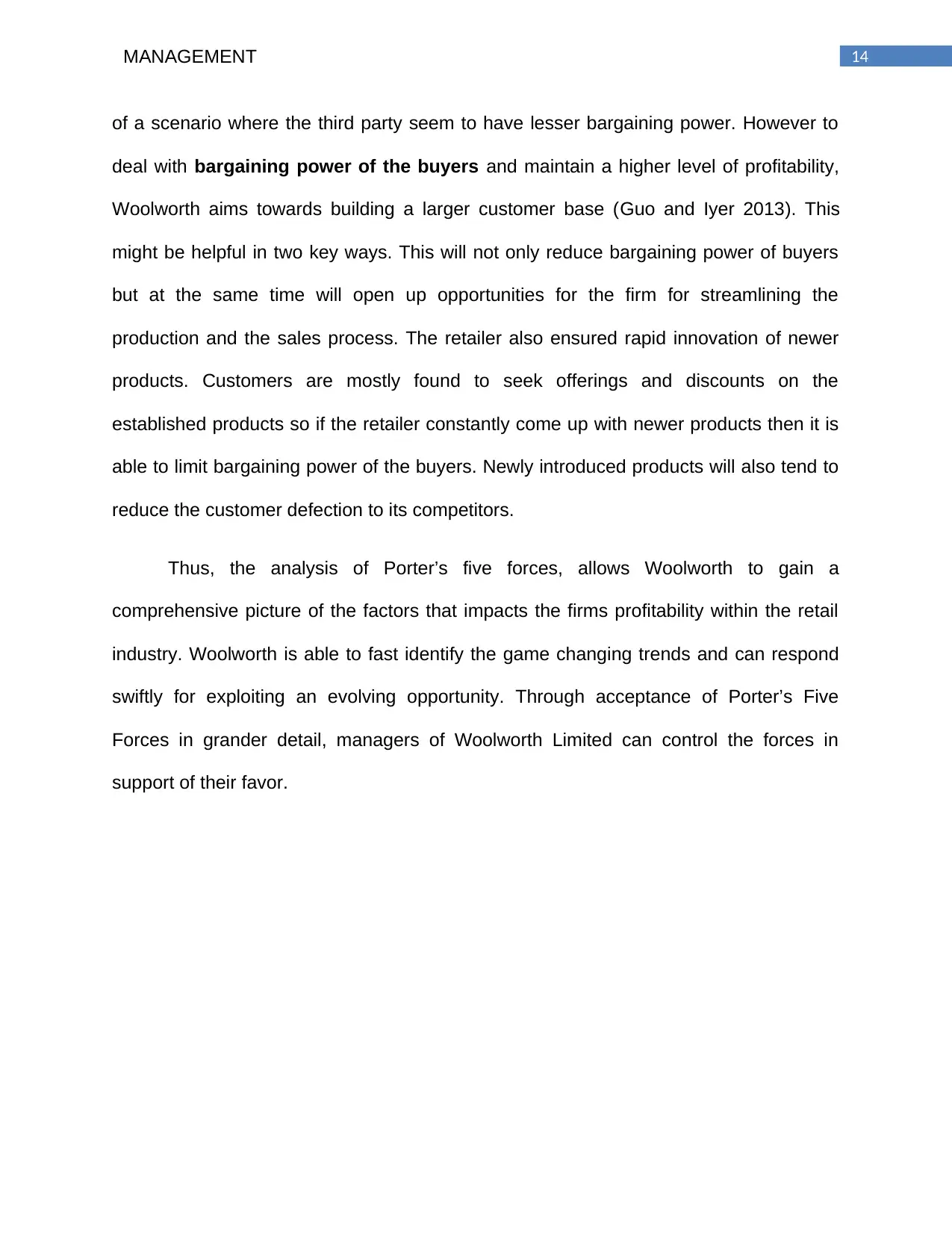
14MANAGEMENT
of a scenario where the third party seem to have lesser bargaining power. However to
deal with bargaining power of the buyers and maintain a higher level of profitability,
Woolworth aims towards building a larger customer base (Guo and Iyer 2013). This
might be helpful in two key ways. This will not only reduce bargaining power of buyers
but at the same time will open up opportunities for the firm for streamlining the
production and the sales process. The retailer also ensured rapid innovation of newer
products. Customers are mostly found to seek offerings and discounts on the
established products so if the retailer constantly come up with newer products then it is
able to limit bargaining power of the buyers. Newly introduced products will also tend to
reduce the customer defection to its competitors.
Thus, the analysis of Porter’s five forces, allows Woolworth to gain a
comprehensive picture of the factors that impacts the firms profitability within the retail
industry. Woolworth is able to fast identify the game changing trends and can respond
swiftly for exploiting an evolving opportunity. Through acceptance of Porter’s Five
Forces in grander detail, managers of Woolworth Limited can control the forces in
support of their favor.
of a scenario where the third party seem to have lesser bargaining power. However to
deal with bargaining power of the buyers and maintain a higher level of profitability,
Woolworth aims towards building a larger customer base (Guo and Iyer 2013). This
might be helpful in two key ways. This will not only reduce bargaining power of buyers
but at the same time will open up opportunities for the firm for streamlining the
production and the sales process. The retailer also ensured rapid innovation of newer
products. Customers are mostly found to seek offerings and discounts on the
established products so if the retailer constantly come up with newer products then it is
able to limit bargaining power of the buyers. Newly introduced products will also tend to
reduce the customer defection to its competitors.
Thus, the analysis of Porter’s five forces, allows Woolworth to gain a
comprehensive picture of the factors that impacts the firms profitability within the retail
industry. Woolworth is able to fast identify the game changing trends and can respond
swiftly for exploiting an evolving opportunity. Through acceptance of Porter’s Five
Forces in grander detail, managers of Woolworth Limited can control the forces in
support of their favor.
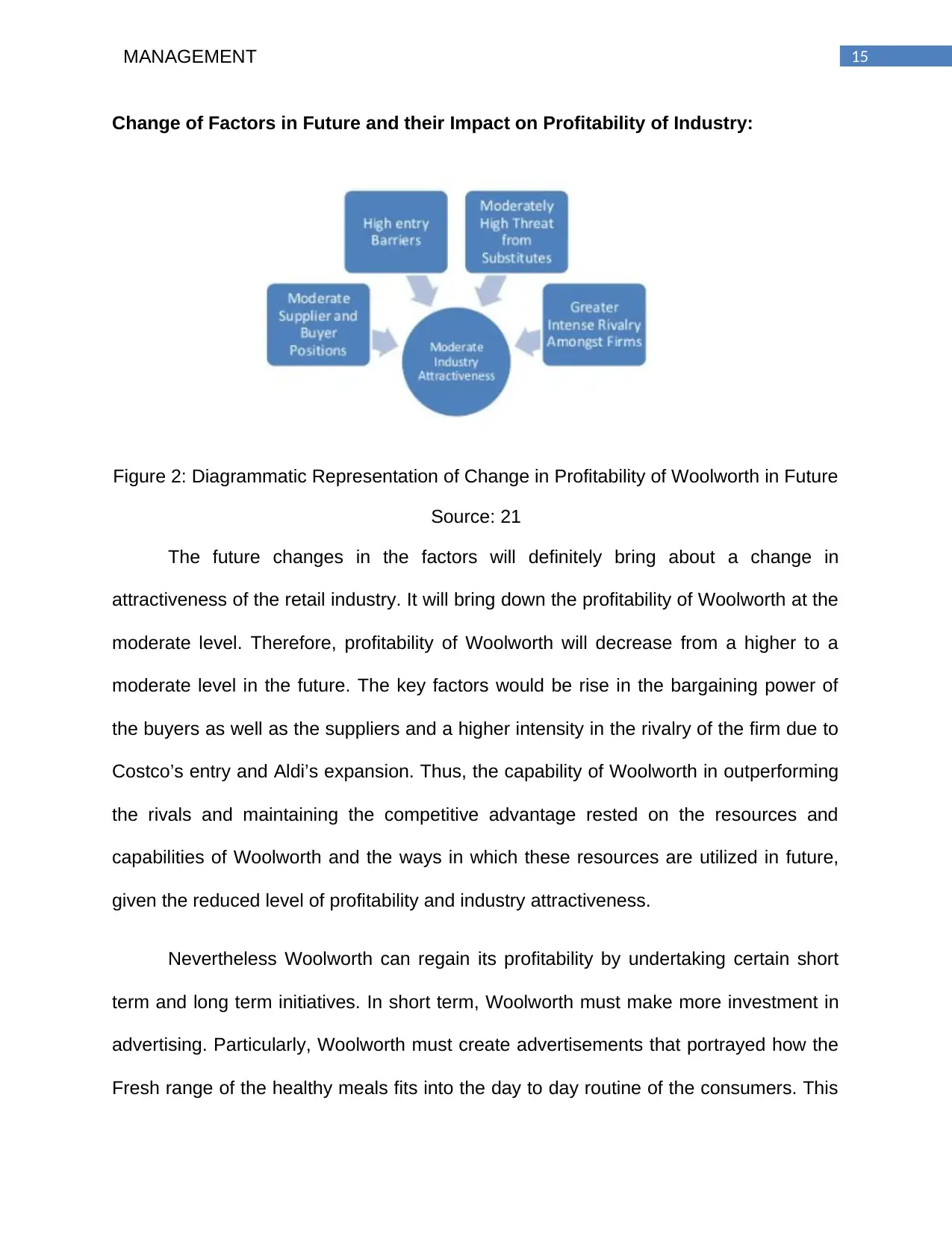
15MANAGEMENT
Change of Factors in Future and their Impact on Profitability of Industry:
Figure 2: Diagrammatic Representation of Change in Profitability of Woolworth in Future
Source: 21
The future changes in the factors will definitely bring about a change in
attractiveness of the retail industry. It will bring down the profitability of Woolworth at the
moderate level. Therefore, profitability of Woolworth will decrease from a higher to a
moderate level in the future. The key factors would be rise in the bargaining power of
the buyers as well as the suppliers and a higher intensity in the rivalry of the firm due to
Costco’s entry and Aldi’s expansion. Thus, the capability of Woolworth in outperforming
the rivals and maintaining the competitive advantage rested on the resources and
capabilities of Woolworth and the ways in which these resources are utilized in future,
given the reduced level of profitability and industry attractiveness.
Nevertheless Woolworth can regain its profitability by undertaking certain short
term and long term initiatives. In short term, Woolworth must make more investment in
advertising. Particularly, Woolworth must create advertisements that portrayed how the
Fresh range of the healthy meals fits into the day to day routine of the consumers. This
Change of Factors in Future and their Impact on Profitability of Industry:
Figure 2: Diagrammatic Representation of Change in Profitability of Woolworth in Future
Source: 21
The future changes in the factors will definitely bring about a change in
attractiveness of the retail industry. It will bring down the profitability of Woolworth at the
moderate level. Therefore, profitability of Woolworth will decrease from a higher to a
moderate level in the future. The key factors would be rise in the bargaining power of
the buyers as well as the suppliers and a higher intensity in the rivalry of the firm due to
Costco’s entry and Aldi’s expansion. Thus, the capability of Woolworth in outperforming
the rivals and maintaining the competitive advantage rested on the resources and
capabilities of Woolworth and the ways in which these resources are utilized in future,
given the reduced level of profitability and industry attractiveness.
Nevertheless Woolworth can regain its profitability by undertaking certain short
term and long term initiatives. In short term, Woolworth must make more investment in
advertising. Particularly, Woolworth must create advertisements that portrayed how the
Fresh range of the healthy meals fits into the day to day routine of the consumers. This
Secure Best Marks with AI Grader
Need help grading? Try our AI Grader for instant feedback on your assignments.
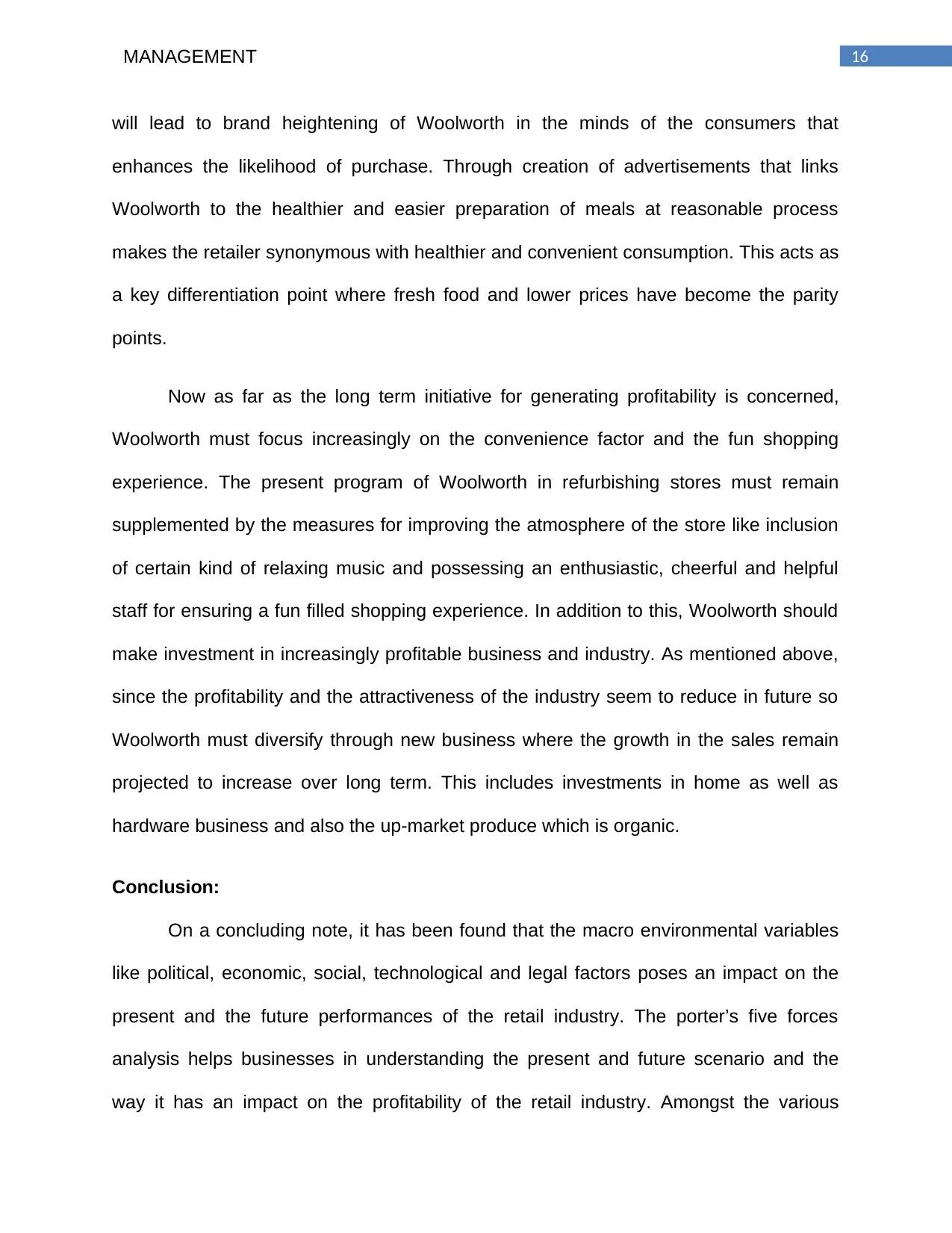
16MANAGEMENT
will lead to brand heightening of Woolworth in the minds of the consumers that
enhances the likelihood of purchase. Through creation of advertisements that links
Woolworth to the healthier and easier preparation of meals at reasonable process
makes the retailer synonymous with healthier and convenient consumption. This acts as
a key differentiation point where fresh food and lower prices have become the parity
points.
Now as far as the long term initiative for generating profitability is concerned,
Woolworth must focus increasingly on the convenience factor and the fun shopping
experience. The present program of Woolworth in refurbishing stores must remain
supplemented by the measures for improving the atmosphere of the store like inclusion
of certain kind of relaxing music and possessing an enthusiastic, cheerful and helpful
staff for ensuring a fun filled shopping experience. In addition to this, Woolworth should
make investment in increasingly profitable business and industry. As mentioned above,
since the profitability and the attractiveness of the industry seem to reduce in future so
Woolworth must diversify through new business where the growth in the sales remain
projected to increase over long term. This includes investments in home as well as
hardware business and also the up-market produce which is organic.
Conclusion:
On a concluding note, it has been found that the macro environmental variables
like political, economic, social, technological and legal factors poses an impact on the
present and the future performances of the retail industry. The porter’s five forces
analysis helps businesses in understanding the present and future scenario and the
way it has an impact on the profitability of the retail industry. Amongst the various
will lead to brand heightening of Woolworth in the minds of the consumers that
enhances the likelihood of purchase. Through creation of advertisements that links
Woolworth to the healthier and easier preparation of meals at reasonable process
makes the retailer synonymous with healthier and convenient consumption. This acts as
a key differentiation point where fresh food and lower prices have become the parity
points.
Now as far as the long term initiative for generating profitability is concerned,
Woolworth must focus increasingly on the convenience factor and the fun shopping
experience. The present program of Woolworth in refurbishing stores must remain
supplemented by the measures for improving the atmosphere of the store like inclusion
of certain kind of relaxing music and possessing an enthusiastic, cheerful and helpful
staff for ensuring a fun filled shopping experience. In addition to this, Woolworth should
make investment in increasingly profitable business and industry. As mentioned above,
since the profitability and the attractiveness of the industry seem to reduce in future so
Woolworth must diversify through new business where the growth in the sales remain
projected to increase over long term. This includes investments in home as well as
hardware business and also the up-market produce which is organic.
Conclusion:
On a concluding note, it has been found that the macro environmental variables
like political, economic, social, technological and legal factors poses an impact on the
present and the future performances of the retail industry. The porter’s five forces
analysis helps businesses in understanding the present and future scenario and the
way it has an impact on the profitability of the retail industry. Amongst the various
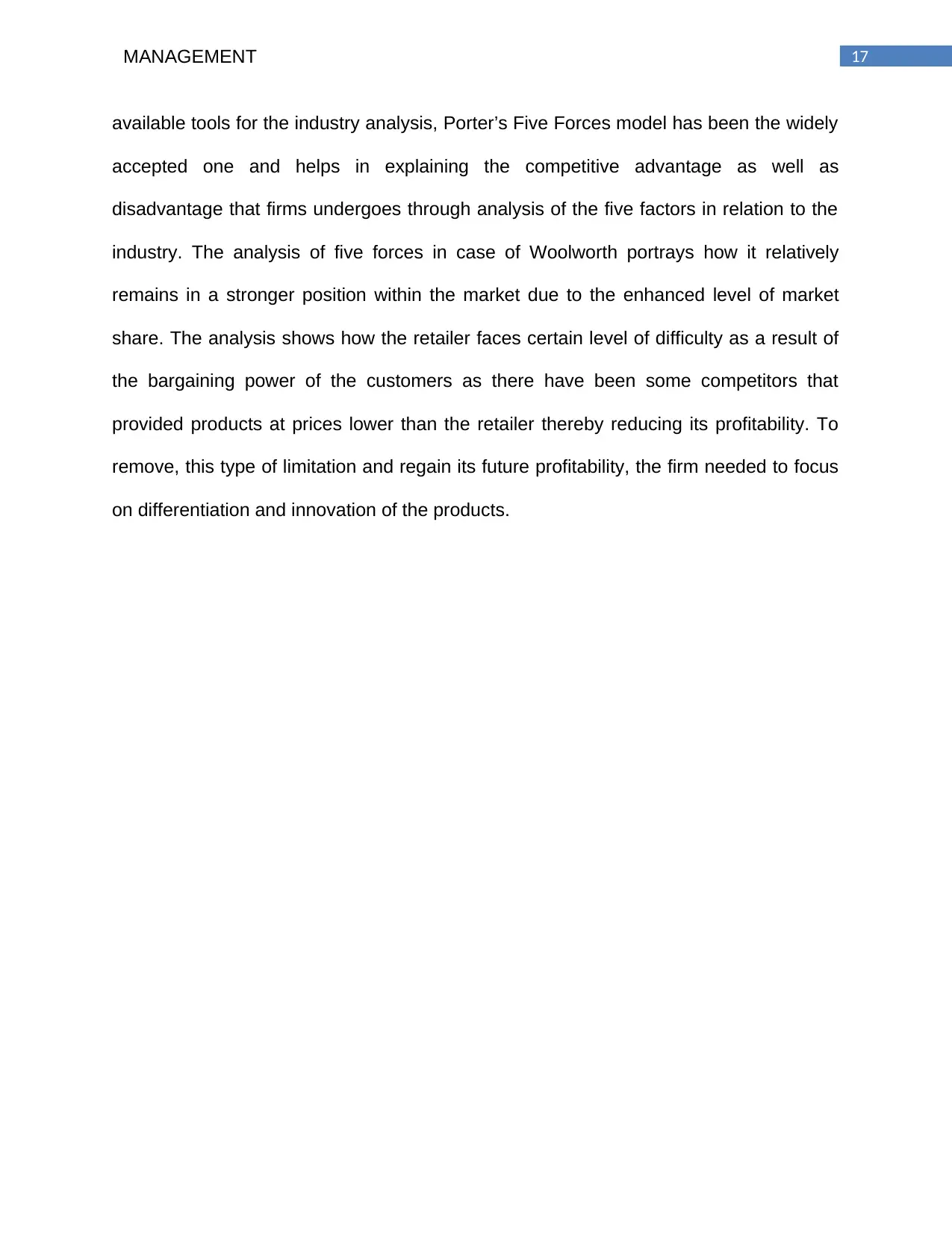
17MANAGEMENT
available tools for the industry analysis, Porter’s Five Forces model has been the widely
accepted one and helps in explaining the competitive advantage as well as
disadvantage that firms undergoes through analysis of the five factors in relation to the
industry. The analysis of five forces in case of Woolworth portrays how it relatively
remains in a stronger position within the market due to the enhanced level of market
share. The analysis shows how the retailer faces certain level of difficulty as a result of
the bargaining power of the customers as there have been some competitors that
provided products at prices lower than the retailer thereby reducing its profitability. To
remove, this type of limitation and regain its future profitability, the firm needed to focus
on differentiation and innovation of the products.
available tools for the industry analysis, Porter’s Five Forces model has been the widely
accepted one and helps in explaining the competitive advantage as well as
disadvantage that firms undergoes through analysis of the five factors in relation to the
industry. The analysis of five forces in case of Woolworth portrays how it relatively
remains in a stronger position within the market due to the enhanced level of market
share. The analysis shows how the retailer faces certain level of difficulty as a result of
the bargaining power of the customers as there have been some competitors that
provided products at prices lower than the retailer thereby reducing its profitability. To
remove, this type of limitation and regain its future profitability, the firm needed to focus
on differentiation and innovation of the products.
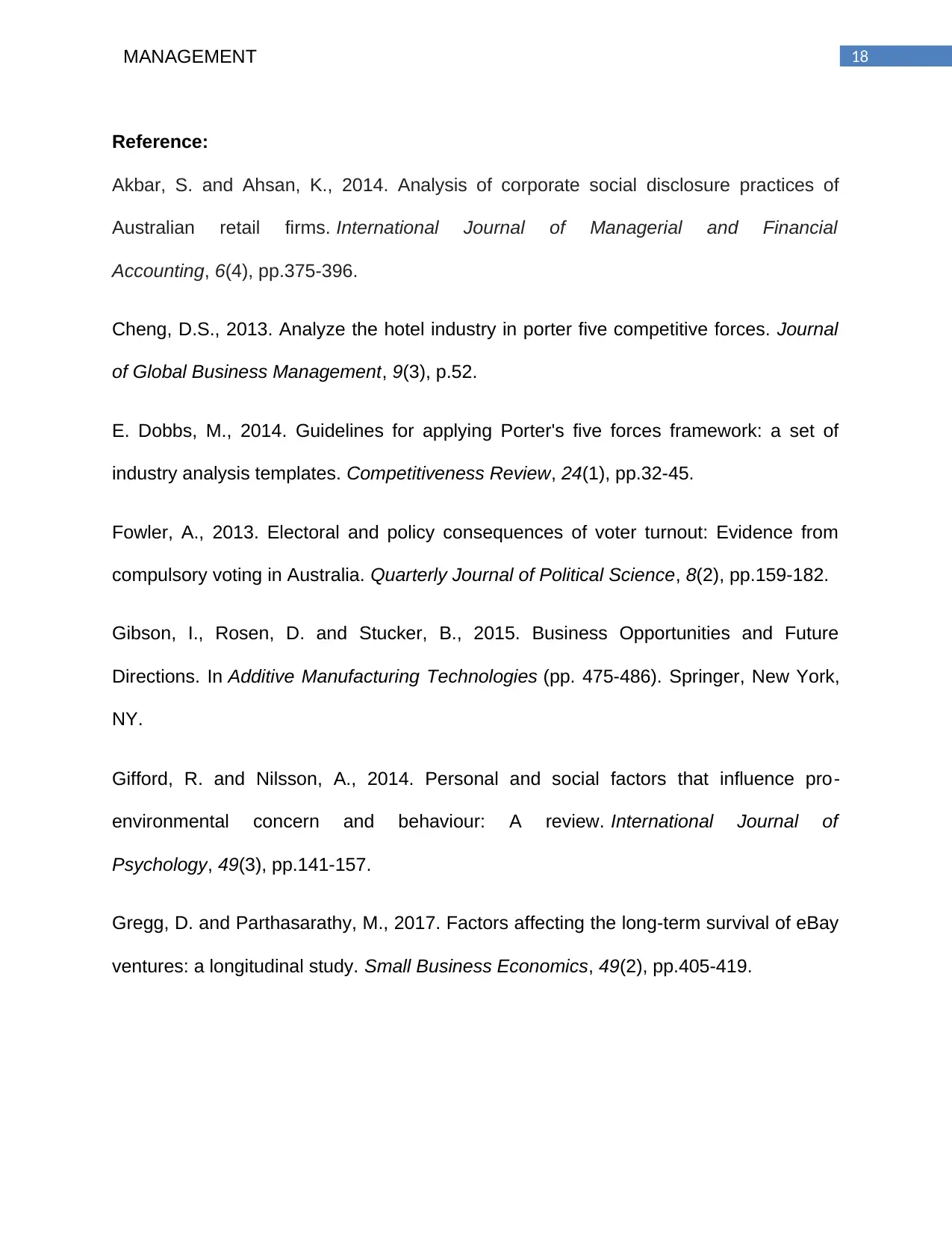
18MANAGEMENT
Reference:
Akbar, S. and Ahsan, K., 2014. Analysis of corporate social disclosure practices of
Australian retail firms. International Journal of Managerial and Financial
Accounting, 6(4), pp.375-396.
Cheng, D.S., 2013. Analyze the hotel industry in porter five competitive forces. Journal
of Global Business Management, 9(3), p.52.
E. Dobbs, M., 2014. Guidelines for applying Porter's five forces framework: a set of
industry analysis templates. Competitiveness Review, 24(1), pp.32-45.
Fowler, A., 2013. Electoral and policy consequences of voter turnout: Evidence from
compulsory voting in Australia. Quarterly Journal of Political Science, 8(2), pp.159-182.
Gibson, I., Rosen, D. and Stucker, B., 2015. Business Opportunities and Future
Directions. In Additive Manufacturing Technologies (pp. 475-486). Springer, New York,
NY.
Gifford, R. and Nilsson, A., 2014. Personal and social factors that influence pro‐
environmental concern and behaviour: A review. International Journal of
Psychology, 49(3), pp.141-157.
Gregg, D. and Parthasarathy, M., 2017. Factors affecting the long-term survival of eBay
ventures: a longitudinal study. Small Business Economics, 49(2), pp.405-419.
Reference:
Akbar, S. and Ahsan, K., 2014. Analysis of corporate social disclosure practices of
Australian retail firms. International Journal of Managerial and Financial
Accounting, 6(4), pp.375-396.
Cheng, D.S., 2013. Analyze the hotel industry in porter five competitive forces. Journal
of Global Business Management, 9(3), p.52.
E. Dobbs, M., 2014. Guidelines for applying Porter's five forces framework: a set of
industry analysis templates. Competitiveness Review, 24(1), pp.32-45.
Fowler, A., 2013. Electoral and policy consequences of voter turnout: Evidence from
compulsory voting in Australia. Quarterly Journal of Political Science, 8(2), pp.159-182.
Gibson, I., Rosen, D. and Stucker, B., 2015. Business Opportunities and Future
Directions. In Additive Manufacturing Technologies (pp. 475-486). Springer, New York,
NY.
Gifford, R. and Nilsson, A., 2014. Personal and social factors that influence pro‐
environmental concern and behaviour: A review. International Journal of
Psychology, 49(3), pp.141-157.
Gregg, D. and Parthasarathy, M., 2017. Factors affecting the long-term survival of eBay
ventures: a longitudinal study. Small Business Economics, 49(2), pp.405-419.
Paraphrase This Document
Need a fresh take? Get an instant paraphrase of this document with our AI Paraphraser
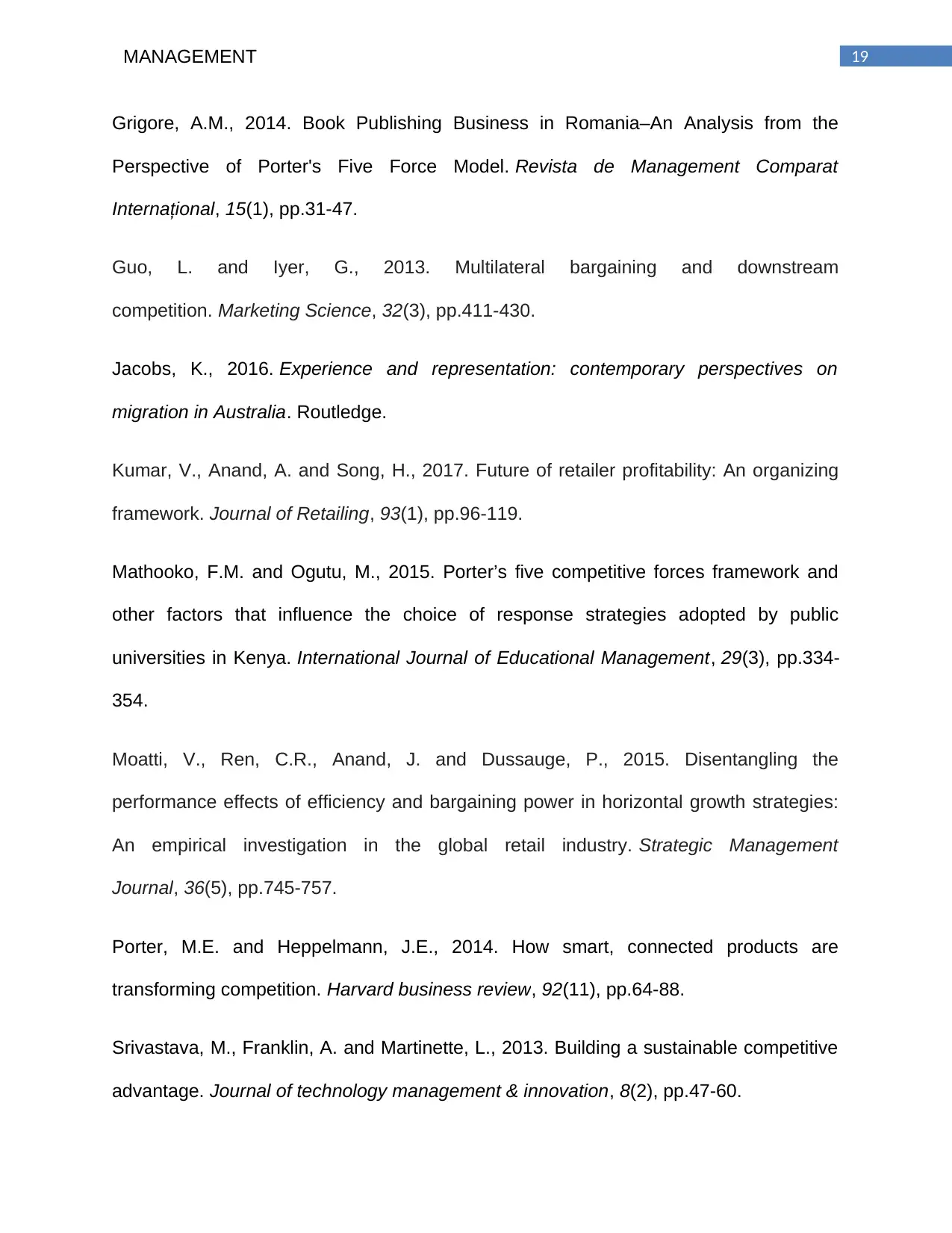
19MANAGEMENT
Grigore, A.M., 2014. Book Publishing Business in Romania–An Analysis from the
Perspective of Porter's Five Force Model. Revista de Management Comparat
Internațional, 15(1), pp.31-47.
Guo, L. and Iyer, G., 2013. Multilateral bargaining and downstream
competition. Marketing Science, 32(3), pp.411-430.
Jacobs, K., 2016. Experience and representation: contemporary perspectives on
migration in Australia. Routledge.
Kumar, V., Anand, A. and Song, H., 2017. Future of retailer profitability: An organizing
framework. Journal of Retailing, 93(1), pp.96-119.
Mathooko, F.M. and Ogutu, M., 2015. Porter’s five competitive forces framework and
other factors that influence the choice of response strategies adopted by public
universities in Kenya. International Journal of Educational Management, 29(3), pp.334-
354.
Moatti, V., Ren, C.R., Anand, J. and Dussauge, P., 2015. Disentangling the
performance effects of efficiency and bargaining power in horizontal growth strategies:
An empirical investigation in the global retail industry. Strategic Management
Journal, 36(5), pp.745-757.
Porter, M.E. and Heppelmann, J.E., 2014. How smart, connected products are
transforming competition. Harvard business review, 92(11), pp.64-88.
Srivastava, M., Franklin, A. and Martinette, L., 2013. Building a sustainable competitive
advantage. Journal of technology management & innovation, 8(2), pp.47-60.
Grigore, A.M., 2014. Book Publishing Business in Romania–An Analysis from the
Perspective of Porter's Five Force Model. Revista de Management Comparat
Internațional, 15(1), pp.31-47.
Guo, L. and Iyer, G., 2013. Multilateral bargaining and downstream
competition. Marketing Science, 32(3), pp.411-430.
Jacobs, K., 2016. Experience and representation: contemporary perspectives on
migration in Australia. Routledge.
Kumar, V., Anand, A. and Song, H., 2017. Future of retailer profitability: An organizing
framework. Journal of Retailing, 93(1), pp.96-119.
Mathooko, F.M. and Ogutu, M., 2015. Porter’s five competitive forces framework and
other factors that influence the choice of response strategies adopted by public
universities in Kenya. International Journal of Educational Management, 29(3), pp.334-
354.
Moatti, V., Ren, C.R., Anand, J. and Dussauge, P., 2015. Disentangling the
performance effects of efficiency and bargaining power in horizontal growth strategies:
An empirical investigation in the global retail industry. Strategic Management
Journal, 36(5), pp.745-757.
Porter, M.E. and Heppelmann, J.E., 2014. How smart, connected products are
transforming competition. Harvard business review, 92(11), pp.64-88.
Srivastava, M., Franklin, A. and Martinette, L., 2013. Building a sustainable competitive
advantage. Journal of technology management & innovation, 8(2), pp.47-60.
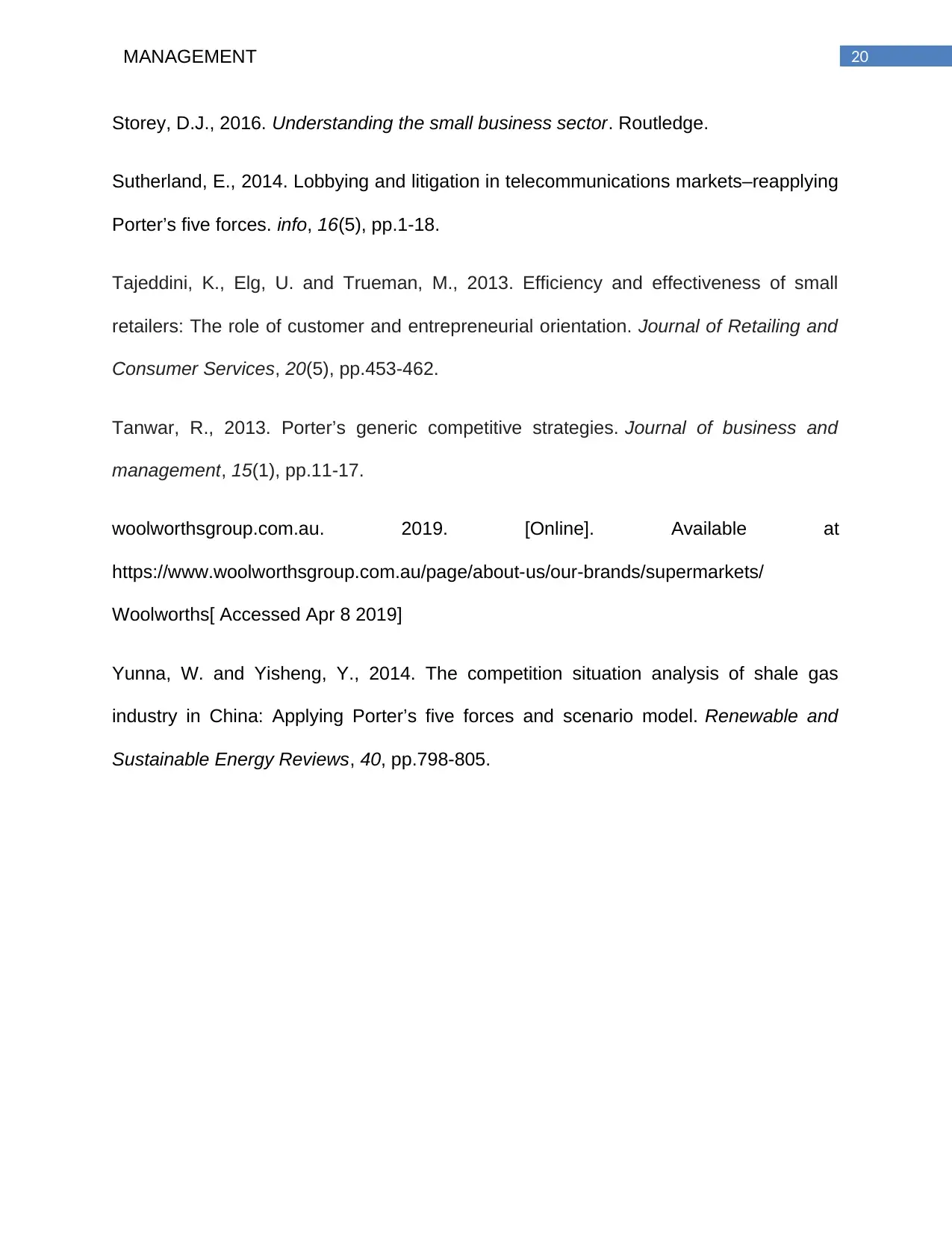
20MANAGEMENT
Storey, D.J., 2016. Understanding the small business sector. Routledge.
Sutherland, E., 2014. Lobbying and litigation in telecommunications markets–reapplying
Porter’s five forces. info, 16(5), pp.1-18.
Tajeddini, K., Elg, U. and Trueman, M., 2013. Efficiency and effectiveness of small
retailers: The role of customer and entrepreneurial orientation. Journal of Retailing and
Consumer Services, 20(5), pp.453-462.
Tanwar, R., 2013. Porter’s generic competitive strategies. Journal of business and
management, 15(1), pp.11-17.
woolworthsgroup.com.au. 2019. [Online]. Available at
https://www.woolworthsgroup.com.au/page/about-us/our-brands/supermarkets/
Woolworths[ Accessed Apr 8 2019]
Yunna, W. and Yisheng, Y., 2014. The competition situation analysis of shale gas
industry in China: Applying Porter’s five forces and scenario model. Renewable and
Sustainable Energy Reviews, 40, pp.798-805.
Storey, D.J., 2016. Understanding the small business sector. Routledge.
Sutherland, E., 2014. Lobbying and litigation in telecommunications markets–reapplying
Porter’s five forces. info, 16(5), pp.1-18.
Tajeddini, K., Elg, U. and Trueman, M., 2013. Efficiency and effectiveness of small
retailers: The role of customer and entrepreneurial orientation. Journal of Retailing and
Consumer Services, 20(5), pp.453-462.
Tanwar, R., 2013. Porter’s generic competitive strategies. Journal of business and
management, 15(1), pp.11-17.
woolworthsgroup.com.au. 2019. [Online]. Available at
https://www.woolworthsgroup.com.au/page/about-us/our-brands/supermarkets/
Woolworths[ Accessed Apr 8 2019]
Yunna, W. and Yisheng, Y., 2014. The competition situation analysis of shale gas
industry in China: Applying Porter’s five forces and scenario model. Renewable and
Sustainable Energy Reviews, 40, pp.798-805.
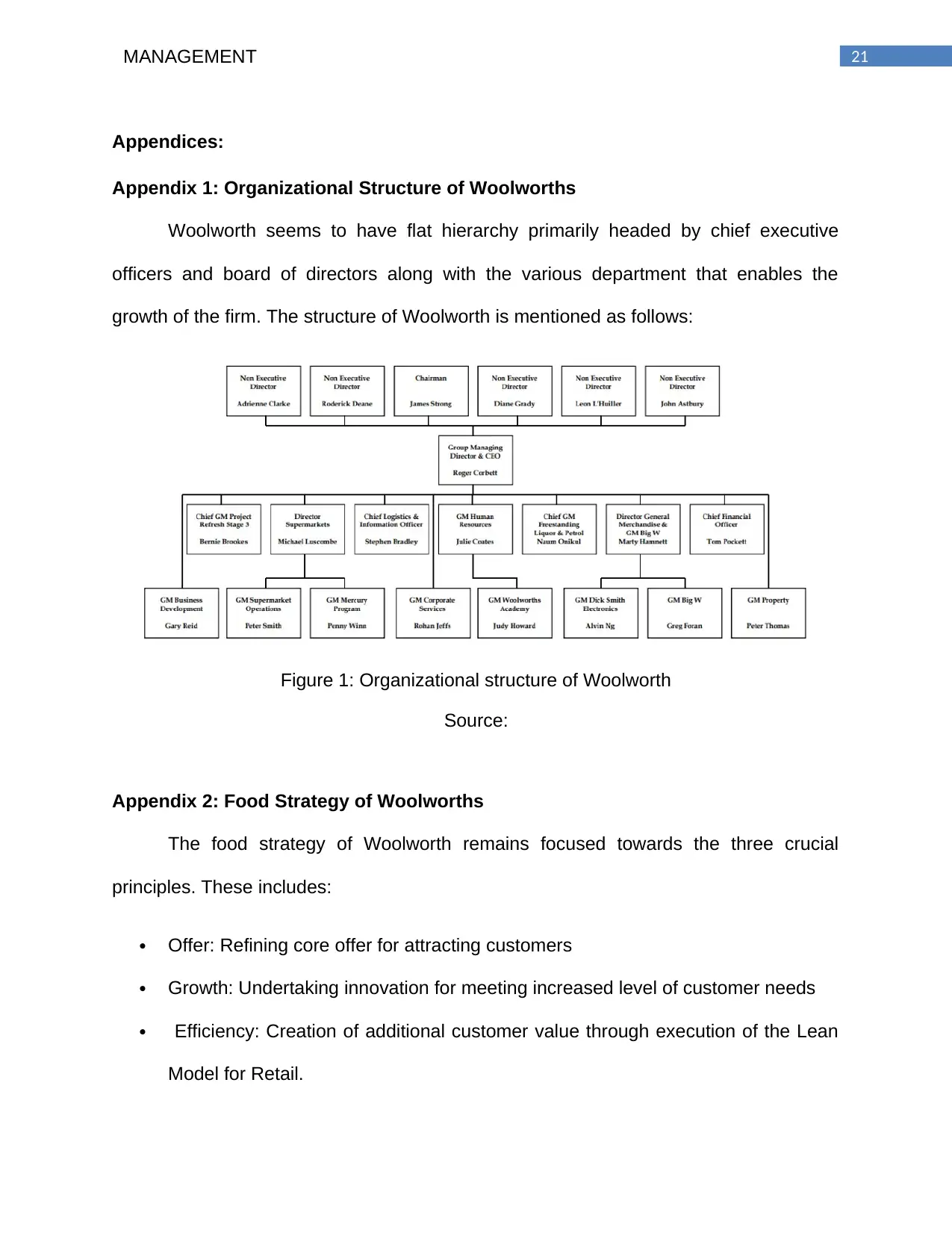
21MANAGEMENT
Appendices:
Appendix 1: Organizational Structure of Woolworths
Woolworth seems to have flat hierarchy primarily headed by chief executive
officers and board of directors along with the various department that enables the
growth of the firm. The structure of Woolworth is mentioned as follows:
Figure 1: Organizational structure of Woolworth
Source:
Appendix 2: Food Strategy of Woolworths
The food strategy of Woolworth remains focused towards the three crucial
principles. These includes:
Offer: Refining core offer for attracting customers
Growth: Undertaking innovation for meeting increased level of customer needs
Efficiency: Creation of additional customer value through execution of the Lean
Model for Retail.
Appendices:
Appendix 1: Organizational Structure of Woolworths
Woolworth seems to have flat hierarchy primarily headed by chief executive
officers and board of directors along with the various department that enables the
growth of the firm. The structure of Woolworth is mentioned as follows:
Figure 1: Organizational structure of Woolworth
Source:
Appendix 2: Food Strategy of Woolworths
The food strategy of Woolworth remains focused towards the three crucial
principles. These includes:
Offer: Refining core offer for attracting customers
Growth: Undertaking innovation for meeting increased level of customer needs
Efficiency: Creation of additional customer value through execution of the Lean
Model for Retail.
Secure Best Marks with AI Grader
Need help grading? Try our AI Grader for instant feedback on your assignments.
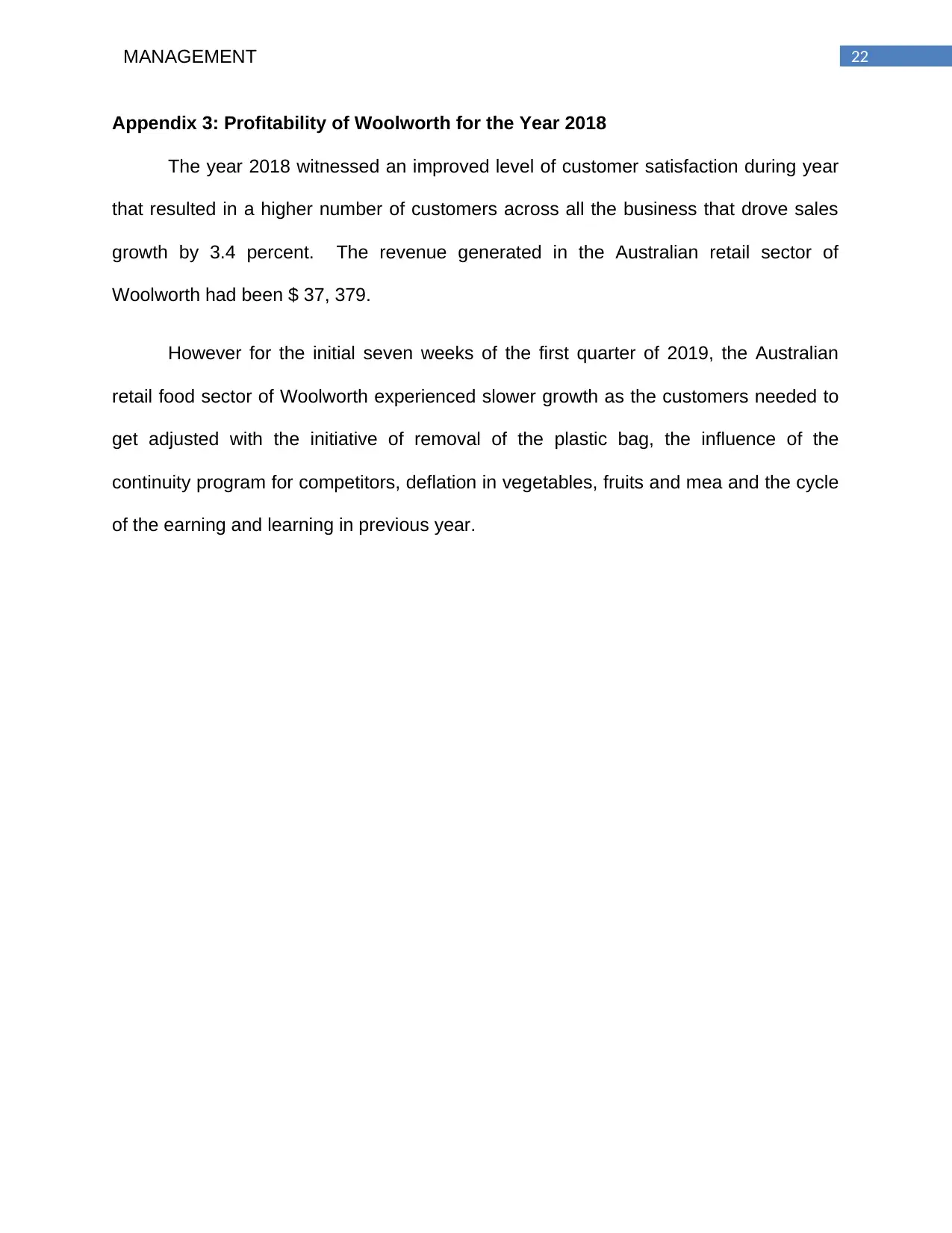
22MANAGEMENT
Appendix 3: Profitability of Woolworth for the Year 2018
The year 2018 witnessed an improved level of customer satisfaction during year
that resulted in a higher number of customers across all the business that drove sales
growth by 3.4 percent. The revenue generated in the Australian retail sector of
Woolworth had been $ 37, 379.
However for the initial seven weeks of the first quarter of 2019, the Australian
retail food sector of Woolworth experienced slower growth as the customers needed to
get adjusted with the initiative of removal of the plastic bag, the influence of the
continuity program for competitors, deflation in vegetables, fruits and mea and the cycle
of the earning and learning in previous year.
Appendix 3: Profitability of Woolworth for the Year 2018
The year 2018 witnessed an improved level of customer satisfaction during year
that resulted in a higher number of customers across all the business that drove sales
growth by 3.4 percent. The revenue generated in the Australian retail sector of
Woolworth had been $ 37, 379.
However for the initial seven weeks of the first quarter of 2019, the Australian
retail food sector of Woolworth experienced slower growth as the customers needed to
get adjusted with the initiative of removal of the plastic bag, the influence of the
continuity program for competitors, deflation in vegetables, fruits and mea and the cycle
of the earning and learning in previous year.
1 out of 23
Related Documents
Your All-in-One AI-Powered Toolkit for Academic Success.
+13062052269
info@desklib.com
Available 24*7 on WhatsApp / Email
![[object Object]](/_next/static/media/star-bottom.7253800d.svg)
Unlock your academic potential
© 2024 | Zucol Services PVT LTD | All rights reserved.




